Alphabetical List of Glass Manufacturers’ Marks (initials, logos, trademarks, emblems, signatures, hallmarks, markings) seen on Antique, Vintage and Modern Bottles, Fruit Jars, Insulators, Tableware and other Glassware, Page One. (A through B listings follow the introductory/explanatory notes, below)
[ A – B ] [ C – D ] [ E – L ] [ M – R ] [ S – Z ]
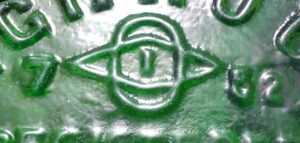
Welcome! I’m interested in the history of the glass industry in the United States, especially the manufacturing of bottles, fruit jars, electrical insulators and tableware. On these five pages I’ve attempted to compile a list of glass manufacturers’ marks (glass factory marks) found on (primarily) American bottles and jars. These glass bottle makers’ marks are sometimes called “punt marks”, especially within the container manufacturing industry.
Also included are a number of trademarks, emblems, signatures and logos seen on other types of glassware including tableware and industrial glass items such as electrical insulators and railroad lantern lenses. Entries on some of the more commonly encountered brand and company names (for instance, Bromo-Seltzer) as seen embossed on antique bottles are also included, as I frequently get questions about them.
Note: the picture above left shows the first trademark used by Owens-Illinois Glass Company – from 1929 into the mid- and late 1950s. This is a typical example, as seen on the bottom of an emerald green “High Rock” ginger ale bottle bearing a date code of 1952. As indicated by the number “7” to the left of the logo, it was made at their main glass plant (O-I plant #7) located at Alton, Illinois. I receive more inquiries about this mark than any other shown on the site, so I’m picturing it here at the beginning of the “Glass Bottle Marks” alphabetical listings pages. It is listed as “Diamond and oval superimposed (entwined) with I in center” (on page two) although oftentimes, especially on smaller bottles, the center “I” is poorly delineated, illegible or virtually invisible. The logo has been described by some observers as reminiscent of the planet Saturn, or a representation of an eye.
Note: For a brief, basic discussion on the material “glass” (without a lot of scientific jargon), please check out my webpage here: What is glass??
Also, please note: When searching the pages (and archived comments) of this website on a computer screen, it may be helpful to press the CTRL (and, while holding it down) the F (Find) key on your keyboard. Then type in a word or letters you are looking for in the search box. This should help to scan the text more quickly for a specific glass factory name, business or company name, city or state name, or other words or initials contained within the text.
If you are using a mobile device, look for the “three stacked dots” or “three horizontal lines” (Menu) along the top or bottom of the screen, tap and look for “FIND IN PAGE” in the dropdown menu. Select that option and a keyboard should appear. Type in the word or phrase to see if it appears within the text on that webpage.
The majority of the marks listed here are found on older glass items, but over the last few years I’ve also tried to include more of the commonly seen trademarks used by present-day glass manufacturing concerns here in the United States. I’ve also included a number of marks seen on glassware made in other countries around the world, but primarily those marks seen on glass that has been imported into the United States.
There are many, many glass manufacturing companies around the world that have made untold billions of glass containers, drinking glasses and other types of glassware, and my list shows only a small percentage of marks that might be encountered worldwide.
Also, please realize that there are a number of marks I list here that could potentially stand for an unrelated company from another country. For instance, in the case of some marks such as “G inside a circle” or “S inside a circle” or just an “M” , very similar marks, in fact basically identical, were also used by totally unrelated companies located outside the United States. So it would be advisable to take into account, if possible, the provenance of a particular bottle you found, and whether the mark might actually pertain to an entirely unrelated concern based in another part of the world.
The reference book “Bottle Makers and their Marks” by Julian Toulouse (1971) which this list is based on (discussed farther down on this page) contains an appendix listing of glass marks used by glass companies around the world, most of which are not listed here. Although the marks listed in his book were in use around the time the book was printed, it can still be very useful for finding worldwide marks, as some have not changed for decades.
For a comprehensive list of present day (or very recently used) glass bottle manufacturers’ marks from around the world, you might also wish to check out the following link showing many of the more recent marks (properly called “punt marks” on their website) which are sometimes seen on bottles imported to the United States. Click here to access a page on the Bucher Emhart Glass site with a link to a recently updated .pdf file illustrating many glass container marks used around the world: Emhart Glass Punt Marks Database (.pdf file)
For a very informative, comprehensive site with lots of detailed discussion on various aspects of antique bottles, including their many types, colors, shapes, methods of manufacture, uses, and clues to dating them, I strongly encourage readers to check out Bill Lindsey’s Historic Glass Bottle Identification and Information Website (hosted by Sha.org). The site is also known as the “Historic Bottle Website” (or HBW). His site is a MONUMENTAL work and has a wealth of great information posted!! There are many pages on the site, and in particular, this page on the site (linked here) includes a lengthy list of detailed articles written by Bill Lockhart (with help from other members of the “Bottle Research Group”) shown near the bottom of the page, under the heading “ENCYCLOPEDIA OF MANUFACTURERS MARKS ON GLASS CONTAINERS” :
Glass Bottle Makers’ Marks – Sha.org -List of Articles
A website that I would also heartily recommend, devoted to dairy-related antiques, is “dairyantiques.com” which is no longer “live” on the internet. However, using the “Wayback Machine” internet archive, please try viewing the site at the following link. I would encourage any milk bottle collectors to try searching their list of marks here: Milk Bottle Marks .
Click here to check another collector’s site that lists a few Australian and English marks seen on older bottles: Some Australian and British marks on bottles.
Australian Bottle Marks. Here is a YouTube video from Australia – “The Ultimate Recycler” channel presents a discussion on some of the more commonly seen base marks seen on antique and vintage bottles found in the Australia and New Zealand area. I enjoyed this video and certainly recommend it! Video with discussion on some Australian bottle marks
Another webpage which I recommend, especially to collectors of tableware and art glass, illustrates many glassmakers’ marks frequently seen on carnival glassware and other upscale glass. Although some of these marks are listed on my site, some of them are not. So be sure to check out Glass Makers’ Marks on Carnival Glass- David Doty’s Site !
Another site with an extensive list of marks is here: Carnival Heaven website – Glass Marks .
Here is another site, this one specializing on information concerning shot glasses: Shotglass.org – Marks Seen on Shotglasses. Most, if not all, of the marks illustrated there are frequently seen on other types of glassware as well, which makes the page quite helpful to a broader spectrum of collecting fields.
ADVERTISEMENT
Art Glass Marks and Signatures
Another very wide field of interest to collectors and researchers on antique, vintage and modern-day glass is what might be called, in a very general sense, “Art Glass”. My site doesn’t go into much detail on that type of glass (with a few exceptions, such as some pressed and blown glass makers including Fenton), but for a site that illustrates lots of signatures and marks used by art glass firms around the world which might be found on more “upscale”, “high end” handmade glass produced by such operations, large and small, please check out this webpage:
Art Glass Marks and Signatures – 20th Century Glass
ANTIQUE BEER & ALE BOTTLES
Researcher/historian Tod Von Mechow has compiled a large quantity of in-depth information on antique beer bottles, including both pottery and glass bottles. I would encourage anyone interested in makers’ marks on beer bottles (and soda bottles) to check out his site….. he has a very extensive list with a lot of great material on obscure glass and pottery companies: Sodas and Beers – Archives – Tod von Mechow’s Website
Some Marks seen on Beer Glasses
I recently found another website that concentrates on information pertaining to beer glasses from around the world, and one of the pages on that site illustrates a number of glass manufacturer marks seen on the bottom of beer glasses. Most, if not all of these marks are also seen on other types of drinkware and tableware. Some of those shown include marks I’ve never seen posted on any other website. So it might be worth a moment to check out this page: Marks Seen on Beer Glasses – Gulliver Taverns Webpage
Usually embossed on the base, marks may also appear on the lower heel area on certain types of bottles, especially sodas. On earlier historical whiskey flasks, fruit jars, and soda bottles, and especially examples produced in the mid-nineteenth century period (1840s-1860s), the full factory name or initials may be embossed across the front (face) or back of the bottle.
This list primarily includes marks that represent the actual glass company that made the container. Many marks are encountered that indicate the company whose product was contained within the bottle, or are trademarks (“brand names”) that give no indication of who actually made the glass, and those (with a number of exceptions scattered here and there throughout the text) are not included in this list.
From the standpoint of most collectors of antique bottles, the name and location of the company the bottle was made for, and the name of the product that was originally contained in the bottle (one or both of which may be embossed on the bottle) is often considered to be of more interest or importance than the glass factory where the bottle was actually manufactured. However, this site is geared with more emphasis on the actual glassmakers themselves. Hopefully this database will be of some help to those who are attempting to assign an approximate date range to a particular bottle or other glass item, assuming it carries an identifiable glass manufacturer’s mark.
NOTE: If initial(s) embossed on the base match the firm name (for instance, of a bottler or brewer) on the front of the bottle, the base mark will more than likely not be that of the bottle manufacturer, and so may not be listed here. This is frequently the case with soda, mineral water, beer and milk bottles of the 1880-1930 period, in which the initial(s) of the “end user” (the soda bottler, brewery, drug manufacturer or distributor, or dairy for which the bottle was made) appear embossed, often in very large bold letters, on the base.
This was especially true of many soda bottles, in which a large single letter is embossed very boldly on the bottle bottom. In those cases, it is believed that the initial (or initials) was marked prominently on the base so that the bottles could be identified and sorted quickly when being returned for washing and refilling. The bottles were often turned upside down when placed into partitioned cases, where the lettering would be readily visible.
Please keep in mind that some marks (esp. initials of early glass companies) may vary slightly in appearance and punctuation from one bottle to another. For instance, they sometimes occur with or without periods after each letter. These variations in punctuation were common and probably reflected the whim of the mold engraver, thus having little or no importance (i.e. for assigning date ranges) especially on marks of pre-1900 bottles. For the most part, I have not attempted to list fine distinctions for marks that are found both with and without periods.
Another source of confusion was the common practice of engraving the “G” (especially in the 1880-1920 period) to appear very similar to a “C”, the only difference between the two being a small stroke or “tail” pointing in a downward or “southeasterly” direction on the lower right-hand side of the letter G. Thus, the mark “A.B.G.M.Co.” might be misconstrued to read “A.B.C.M.Co.” Also, the abbreviation “Co” (Company) sometimes may be found embossed with either an upper- or lower-case “O” on various bottles made by the same manufacturer.
DATE RANGES shown on this site: The years of business (and date ranges given for various marks listed) shown on these pages are the best I have (so far) and I’ll freely admit that many of them are not precise, and are occasionally subject to change as more research is done and better info uncovered. I am always trying to update entries and keep abreast of the latest research, but am always “behind the curve” to some extent as there is so much to learn.
ADVERTISEMENT
There are discrepancies between dates shown on this site as compared to information from other sources (both online and in reference books). Earlier writers on glass including Helen McKearin, Kenneth Wilson, Rhea Mansfield Knittle, Julian Toulouse, Adeline Pepper, Dick Roller and others wrote books with the very best information they had at hand, and that was long before the internet age!
More recent (and ongoing) research by Bill Lockhart, Tod Von Mechow, Jay Hawkins and others have been very helpful in correcting and “fine tuning” date ranges for glass companies (and some of the marks each used for shorter periods of time while a particular company was in operation). The word “circa” or “c.” has been used rather heavily in these pages. Please keep in mind that I’d like the information presented here to be as accurate as possible, but as human beings we are not perfect and there will be mistakes here and there in the text.
Generally speaking, I may not be able to answer questions concerning bottles with only mold or catalog numbers embossed on the base. THOUSANDS of bottles carry only a number on the base (or heel), and this information (in many cases) does not help ID the source or age. Nearly all glass factories used mold numbers on their containers at one time or another. However, the general style, shape, manufacturing technique used, and glass color of a container can give strong clues to approximate age.
Numbers often served as some type of mold identification, indicating a particular mold used by a glass factory. If a number of identical molds were produced for making a certain type of bottle, they would often be serially numbered (such as 1 to 12). Some numbers served as date codes, or as some other type of internal code used by the factory. In the great majority of cases, bottles with only numbers on the base are difficult, if not impossible, to attribute to a specific glass maker. Please see my webpage here with more info on Numbers seen on the bottoms of glass bottles and jars.
Much of the basic information here on the alphabetical “Marks” pages comes from research by Julian H. Toulouse published in his classic, indispensable and ground-breaking reference work Bottle Makers and their Marks (1971). That 624-page book is the best reference work ever published on glass manufacturers’ marks on bottles, but admittedly it does contain quite a few errors which have been discovered over the last 50+ years since its original publication.
Other sources of information I have used (including reference books, magazine articles, websites, and in a few cases, email or voice communications) would include: Helen McKearin, Rhea Mansfield Knittle, Stephen Van Rennselaer, Harry Hall White, Alice Creswick, Dick Roller, William S. Walbridge, Cecil Munsey, Roger Peters, Gene Blasi, Adeline Pepper, Arthur G. Peterson, Bob Stahr, Fred Padgett, Rex L. Wilson, John O’Dell, Bill Lockhart, Jeffrey L. Giarde, David Bethman, Arleta Rodrigues, Frances Terrill, Joe Maurath, Jack Tod, Ray Klingensmith, Elton Gish, Douglas Leybourne, Jr., Vivian Kath, Betty Zumwalt, Jay W. Hawkins, Peter R. Guetig, Conrad Selle, Tod Von Mechow, Don Dzuro, Johnnie W. Fletcher, Norman “Ted” Oppelt, Dick Cole, Harvey Teal, Dean Six, Tom Neff, Bruce Mobley, Ron Fowler, Albert Morin, John P. Adams, Philip K. Huggins, Jack K. Paquette, Bill Lindsey, Carol Serr, Bob Brown, Peter Schulz, Beau Schriever, Russ Hoenig, Mark Newton, Lee Brewer and Dave Beeler, as well as many others.
In addition, I want to extend a hearty THANK YOU to the many individuals who have sent me photos of glass marks over the years. Some of those photos appear within the text of the alphabetical marks listings, with credit given to the contributor. (Most photos without a credit in the caption were taken by me).
This site also utilizes, to some degree, my own research and observations over several years of collecting & studying antique bottles, insulators and other glassware. I hope this list will be of assistance to those interested in antique bottles and other glass containers made in the United States and the history behind the factories that manufactured them.
I am striving to add more articles on this site relating to glass and glass collecting, both of a general nature, and addressing certain collecting “niches”, as time and energy permits! I hope you will return often to this site!! THANK YOU!!
I will occasionally be adding more data to these pages as I uncover more accurate information. The info presented on this site is the most accurate I’ve been able to find at present, but any comments (pro or con), clarifications or corrections (preferably backed up with reliable source information) would be sincerely appreciated!!!
Because of the volume of emails I receive, I may or may not be able to respond to questions about marks not listed here. You are more than welcome to contact me, (see Contact Information), but please be aware that this site is NOT intended as an appraisal service, and I may not respond to queries along the general lines of “what is this jar worth?” and “is this bottle worth the hassle of listing on ebay?”.
Often, I simply don’t know the answers to a lot of questions that are sent to me. The wide world of glass and bottle collecting is a TREMENDOUS field and there are many, many unanswered questions still out there concerning bottle markings, glass manufacturers’ histories, etc.
I should mention that only a small percentage of comments received are actually published on this site, since if every one was answered and published, my site would soon be loaded down with thousands of comments that could cause the pages to load more slowly for those with slower or older computers.
Thank you very much! David
COPYRIGHT ISSUES
I occasionally surf ebay and other online sales sites, and I have found that (very frequently) sellers copy and paste segments of text from this site, ranging from a few sentences to several paragraphs, or even many paragraphs, WITHOUT any credit as to the source of the information they are copying. Although my text is copyrighted by default, I can’t do anything to stop ebay sellers from copying and pasting content from this site. So I merely ask sellers to PLEASE include the source of the text you are using: please cite it as “courtesy of GlassBottleMarks.com”. Also, please keep in mind this website is free but costs money to keep “up and running”, and my costs are defrayed by having ads inserted on the pages. THANK YOU!
Please click here to go to my site Welcome / Home Page.
ADVERTISEMENT
Alphabetical List of Glass Manufacturers’ Marks on Bottles, Fruit Jars, Insulators, Tableware and other Glassware, Page One
Note: some glass marks are “pictorial” in nature, are hard to describe and are difficult to place logically in an alphabetical context. For a handful of marks that I haven’t been able to identify (yet), and which were also hard to decide where to place in the list – please check the images (entries) placed at the very bottom of the alphabetical listings on Page Five (S-Z).
[ A – B ] [ C – D ] [ E – L ] [ M – R ] [ S – Z ]
- A…………………The letter “A” is sometimes merely a mold letter (identifying a particular mold used by a glass factory). If it is an abbreviation for a glass factory, it could stand for one of several companies. One possibility: Agnew & Company, Pittsburgh, Pennsylvania (c.1854-1894+). See “A & CO.” mark. Another possibility would be Adams & Company, Pittsburgh, Pennsylvania (1861-1891). Originally Adams, Macklin & Company (1851-1861), they did manufacture at least one type of fruit jar circa 1866, lettered “Adams & Co. / Manufacturers / Pittsburgh, Pa.” on the front. However, the great bulk of their glass production seems to have been pressed pattern glass and high-quality tableware and novelties, especially throughout the later years of their operation. In 1891, they joined the merger known as the United States Glass Company. Note: If the bottle is machine-made, the letter “A” would indicate a much more recent company, perhaps Arkansas Glass Container Corporation, Jonesboro, Arkansas (1948-to date). See “A.G.C. in state of Arkansas” and next entry, below.
- A (on the base of mouth-blown soda bottles made in Great Britain)…………. uncertain. Many handmade soda / mineral water bottles (with applied-lip blob or crown-type tops and a somewhat rounded base) are found with an “A” on the bottom, sometimes with accompanying dots and number codes. The glass is most commonly of a light greenish color, as seen in many bottles from Britain. In these cases the mark is currently unidentified with certainty. One very strong possibility would be Alloa Glass Work of Alloa, Clackmannanshire, Scotland. The bottles appear to date from the c. 1880s perhaps up into the 1910s. (Thank you to archeologist Sandi Ratch for bringing these “A” marks to my attention) !
- A (stylized triangle with “A” as central motif)………….Arkansas Glass Container Corporation (Arkansas Glass), Jonesboro, Arkansas (1956-to date). I am not positive this trademark has actually been used on containers, although it has been displayed on their website. If you have up-to-date information on this mark, please contact me!
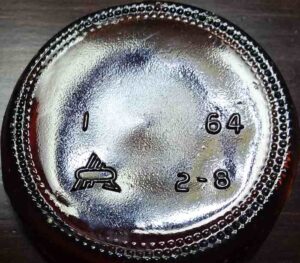
American Can Company- Glass Products Division trademark – here on base of amber beer or soda bottle bearing 1964 date code. - A (stylized logo – barred triangular design overlain by an oval, as shown in photo above)…………………… American Can Company – Glass Products Division, Cliffwood, New Jersey; Terre Haute, Indiana and Shakopee, Minnesota (c.1963- c.1968). Successor to American-Wheaton Glass Corporation. (See “A W inside an oval” entry on this page, below). Bought out in 1968 by Midland Glass (see Midland mark – stylized M logo, frequently seen on the bottom of stubby type beer bottles). Some more information on this mark and other “A” marks can be found in this article by Bill Lockhart and the Bottle Research Group: Other A Marks – Sha.org
- A & CO…………Adams & Company, Pittsburgh, PA (1861-1891) and/or Agnew & Company, also of Pittsburgh (c.1854-1894+). 1) Adams & Company is considered as the most likely producer of several “Clasped Hands” figured flasks from the 1860s bearing this mark on the front, as attributed by Jay Hawkins, researcher on early Pittsburgh glassmakers. If so, they were produced in the early years of that company before they began to concentrate (primarily) on pattern glass tableware. 2) In reference to Agnew & Company, there was a series of glass companies in the Pittsburgh area in which the Agnew family was involved, beginning as early as 1842 with Chambers & Agnew. Later, approximately 1854, the firm became John Agnew & Company (1854-1870); then, John Agnew & Son (1871-1876) and later simply Agnew & Company (1876-1892+). The most recent incarnation seems to have been “The Agnew Company”, which was in operation in 1894 (a bottle catalog from this company exists, dated 1894) which may have continued on for some time afterwards. Jars that are marked “JOHN AGNEW & SON / PITTSBURG PA” presumably date from about 1871 to 1876, and those marked “AGNEW & CO / PITTSBURG PA” would date from c. 1876 into the early 1890s. Also, please see “A” and “Agnew & Co”. entries.
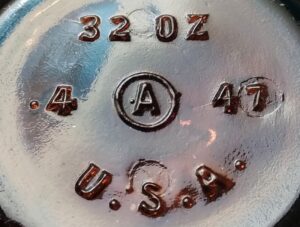
“A in a circle” on 32 ounce chemical bottle made by Armstrong Cork Company. The “47” is a date code for 1947. - A in a circle…………… Armstrong Cork Company (Glass Division), Lancaster, Pennsylvania; Millville, New Jersey [former Whitall Tatum Co. plant] and Dunkirk, Indiana [former Hart Glass Manufacturing Co. plant, acquired by Armstrong in 1938]. Mark was used from 1938-1969 on bottles, jars and electrical insulators. If there is a line underneath the “circled A”, this indicates the bottle was produced at the Dunkirk plant. The entire name “Armstrong” (with a circle around the “A”) is also seen on some bottles. Please eee “Armstrong”, as well as the next entry.
- A in a circle…………………. on earlier handblown or machine-made bottles (unrelated to Armstrong), probably American Glass Works, Richmond, Virginia ( 1907- 1925). This mark has been seen on the bottom of a few light aqua or colorless shoofly (“coffin”) flasks, picnic (“pumpkinseed”) flasks, and rectangular medicine bottles. Those bottles may date before around 1913. See “A G W” entry on this page. For more information on this particular “A in a circle” mark and American Glass Works, please see this article by Bill Lockhart and the Bottle Research Group: https://sha.org/bottle/pdffiles/AmGWRichmond.pdf
- A in a diamond…………Unknown
- A , entwined with a bird emblem with wings outstretched; appears as if flying through the “A”. The logo actually represents a crow (a play on the company name) with glass marbles clutched in its talons and beak, but may be mistaken for an eagle or other bird of prey…………………..Akro Agate Company, Akron, Ohio (1910-1914) and Clarksburg, West Virginia (1914-1951). Maker of toy glass marbles as well as ashtrays, vases, children’s dishes and many other unusual novelty items. Akro Agate items are found in a wide variety of opaque and “slag” (marbled, multicolored) glass.
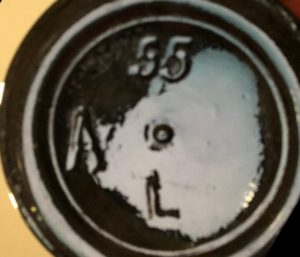
A / L / 55 – Unknown marking on dark olive green bottle (Photo courtesy David Hubbard) - A / L / 55 (Unknown manufacturer – see pic). This marking is on the base of a handblown “three-piece mold” dark olive green liquor bottle, with a label for W. Williams & Company, Aberdeen, Scotland, which was in business c.1897-1919. The bottle itself may be American, as the bottle was filled with whisky (in Chicago) that had been shipped over in casks from Scotland. Either the “A” or the “L” could be the first initial of the unknown glassmaker.
- A. Arbogast, Pitts…………..Alexander Arbogast / Arbogast & Company, Pittsburgh, Pennsylvania (c. 1860-c.1863). Mark is pictured in Bottles on the Western Frontier by Rex L. Wilson (1981:113), seen on a cylinder whiskey. See “Arbogast & Co. Pitts Pa”.
- A B (letters are not connected)………………uncertain, evidently either American Bottle Company or Adolphus Busch Glass Manufacturing Company. Please see AB (connected) page, “AB (connected) Co”, and “A.B.CO” entries.

AB (connected) mark on base of light aqua beer bottle – with P 11 code - AB (letters connected, shown) ………………….. Please see this page where this mark is discussed in more detail.
- AB (letters connected) Co…………….. Adolphus Busch Glass Manufacturing Company (1886-c. 1921) and American Bottle Company (1905-1929). Also, please see this page, and “A.B.CO.” mark.
- A B & Co (as seen on the base of blackglass ale or wine bottles)……….. Unknown maker. This mark has been seen on blackglass (very dark olive green or olive amber) bottles that appear to be from Great Britain, and probably date from sometime in the 1860-1900 time period. (There is no relation of this mark to the “A B CO” mark used by American Bottle Company). The letters are rather crudely and largely embossed, and arranged in a circular orientation on the bottom of the bottle. The bottles have been occasionally reported from such far-flung places as Suriname and Cuba, and were evidently exported around the world from Great Britain in the mid / late nineteenth century. If you have info on other places these bottles have been found, please contact me. These bottles are similar in general appearance to the black glass “C W & Co” bottles that were made by Carson, Warren & Company of Glasgow, Scotland.
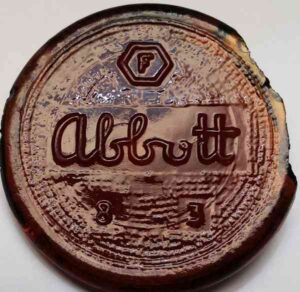
“Abbott” on base shard from amber bottle made by Fairmount Glass Company. - Abbott (in cursive script)………….. Abbott Laboratories, headquartered in Chicago, Illinois (1888- to present) . Although the surname “Abbott” is occasionally seen on bottles from several other, unrelated companies (such as on the C. W. Abbott bitters bottles from Baltimore), in this particular case the name, in a characteristic, rather stylish lettering, pertains to the pharmaceutical giant based in Chicago. The name was evidently embossed on a variety of bottles and jars that contained their pharmaceutical products. In the accompanying photo, the Abbott name is shown as it appears on an amber bottle base. The shard is from a bottle made by Fairmount Glass Company of Indianapolis, Indiana (F inside a hexagon). That bottle probably dates from the 1940s or 1950s.
- A.B.C……………..Atlantic Bottle Company, Brackenridge, Pennsylvania (c.1916-1930). First only a distributor (pre-1916), Atlantic was later an actual manufacturer of bottles. The Brackenridge plant was purchased by Owens-Illinois in 1930.
- A.B.Co……………………….. American Bottle Company (1905-1929). Chicago, Illinois (office – 1905-1916); Toledo, Ohio (office – 1916-1929). Glass plants were located at Streator, Illinois; Newark, Ohio; Belleville, Illinois; Massillon, Ohio & Wooster, Ohio. The American Bottle Company was purchased by Owens Bottle Machine Company in 1916 (with some of the plants being closed soon afterwards) but the Streator and Newark plants continued to operate under the American Bottle Co. name until 1929, when they became part of the merger that resulted in Owens-Illinois Glass Company. (For Streator and Newark plant marks from 1916 to 1929, see “17N” and “16S” entries). Most, if not all, of the “AB”, “AB CO.” and “A.B.CO.” marked bottles are believed to date between 1905 and 1916. However, it is possible that some bottles with these markings might date between 1916 and 1929, but, if so, could only have been made at either the Streator or Newark plants. See also “AB (letters connected)” page.
- A.B.G.CO………….. Adolphus Busch Glass Company (1886- c.1893) with a slight company name change to “Adolphus Busch Glass Manufacturing Company” (c.1893-c.1921). Also see the “A.B.G.M.CO.” mark which was used after about 1893 up to c. 1921, and this page on the AB Connected mark seen on Antique Beer Bottles.
- A. B. G. C. ST. L. ……………. Adolphus Busch Glass Mnfg. Company (Presumably produced at their St. Louis glass factory location post-1891). See next entry.
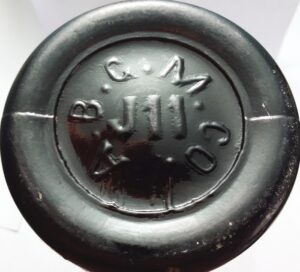
A.B.G.M.CO. mark on base of dark amber export beer bottle – Adolphus Busch Glass Manufacturing Company. - A.B.G.M.CO………… Adolphus Busch Glass Mnfg. Company, plants at Belleville, Illinois (1886-c.1905) and St. Louis, MO (c.1893 – c. 1921). The Belleville factory became part of American Bottle Company c.1905. (See AB (connected) and A.B.CO. marks). ABGMCO produced huge quantities of beer bottles for Anheuser-Busch Brewing Association, but also beer bottles for other brewers and bottlers, as well as other types of containers including soda bottles and wax sealer style fruit jars. Without the original label intact, it would be difficult or impossible to be sure what brand of beer any particular bottle marked “A.B.G.M.CO.” originally contained. The lettering is typically arranged in a circular fashion, and usually accompanied by a mold letter/number placed in the center of the base. Also see “A B G CO” which was evidently used in the first few years of operation.
- A.B.G.M.Co. Belleville Ill. ………………………… Adolphus Busch Glass Manufacturing Company, denotes beer bottles made at their Belleville plant (1886-c.1905). This marking is not very common, compared to other marks used by Adolphus Busch, so it is likely they used that mark for a relatively short time, with only a few shops (teams of glassworkers) producing them. The mold numbers “1” through “4” are known, but perhaps higher numbers exist that have not yet been reported.
- A.B.G.M.Co. ST. L………….. Adolphus Busch Glass Manufacturing Company, bottles made at their St. Louis plant location. See above entries, and AB Connected mark.
- A C B Co (letters arranged in a circular formation on base of early handblown light green or aqua Lea & Perrins Worcestershire Sauce bottles)…………… Aire & Calder Bottle Company, Castleford, Yorkshire, England (c.1836 – c.1913). The exact years this glassworks was in business is uncertain (sources of info vary), but a Lea & Perrins bottle (found among artifacts recovered from the October 1865 sinking of the sidewheel steamship SS Republic off the coast of Georgia) proves those initials were being embossed on bottles at least by that year, if not much earlier, possibly dating back to the 1840s or 1850s. These are believed to be the earliest Lea & Perrins sauce bottles that were exported to the United States.
- Acorn logo (shown, as seen on the base of a small medicine bottle)………Bellaire Bottle Company (Works), Bellaire, Ohio (1882-1922). Logo is occasionally seen on the base of handblown clear glass prescription/medicine bottles. This logo possibly dates from the earlier years of the company, perhaps up to circa 1895. (Thanks to David Bethman for emailing me with info on the source of this mysterious acorn mark!) He reports that the mark appears on a Bellaire Bottle Company letterhead shown in a reference book by Scott Tyson called “Glass Houses of the 1800s” (1971). For an article with more extensive background material on Bellaire Bottle Company, check out this .pdf file by researcher Bill Lockhart et al: https://sha.org/bottle/pdffiles/Bellaire.pdf
- Adlam’s Patent (on base of jars)…….. Several different jars are known with such embossings as “ADLAM’S PATENT” or “PAT. GLASS PAIL / BOSTON MASS” on base. They came with unusual metal screw lids; some lids are marked “ADLAM PATENT PAIL”. Patents were issued to Samuel Adlam, Jr. of Boston. These jars evidently date from the 1880s or 1890s. Currently, the glass manufacturer that made these jars is unknown / unidentified.
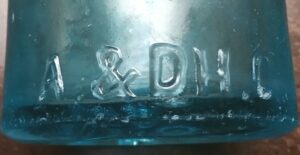
“A & D H C” mark on heel of blob top “squat” Schanzenbacher, Louisville KY mineral water bottle. - A. & D. H. C. ………………… Alexander & David H. Chambers, Pittsburgh, Pennsylvania (c. 1852–c.1889). This was one of the most prolific glass companies in Pittsburgh during the mid-to-late 1800s. Huge quantities of bottles, flasks, and fruit jars were made, as well as window glass (which was ostensibly their primary product). Many local, regional, and nationally distributed sodas, ales, mineral waters, beers, bitters, tonics, and other types of products were packaged in bottles made by A&DHC. Most commonly, bottles with this mark seem to date from the 1870s and 1880s, but the mark was evidently in use from around 1860. Most bottles made by A & D H C in the earlier years (1840s and 1850s) evidently did not bear a glass manufacturer’s mark. For more detailed background on A&DHC, please check out this article by Bill Lockhart et al here: https://sha.org/bottle/pdffiles/A&DHChambers.pdf
- Adams & Co…………. See “A” entry.
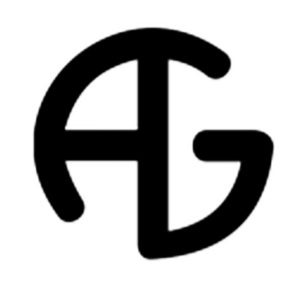
AG logo – A and G arranged in a circle, connected to form a monogram – ARCYA Glass Corporation. - AG (stylized letters joined together as a circle, as shown above)……………. Arcya Glass Corporation, Calamba, Laguna, Philippines and Makati City, Manila, Philippines (1966- c.2021?). Exact timeline for this mark is uncertain. The official Arcya website seems to have disappeared from the web by mid-2021. The factory was undergoing employee layoffs and chaos in November and December of 2020, evidently related to the Covid-19 pandemic. I believe this company was later acquired by another firm (possibly BestPak Packaging Solutions ?) sometime after 2021 but don’t have further information/clarification on that.
- AG (stylized letters forming an anchor)……..Anchor Glass Container Corporation. See “Anchor….” entry, farther down on this page.
- A G C (letters are diagonally arranged, oriented from “Northwest” to “Southeast”)………….Arkansas Glass Container Corporation, Jonesboro, Arkansas (1956-to date). See next entry.
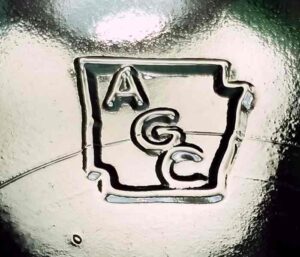
“AGC inside outline of the state of Arkansas” mark – as it appears on the base of a clear glass half-gallon packer jar. - AGC / A G C (letters placed within outline of the state of Arkansas, shown above) ……………….. Arkansas Glass Container Corporation, Jonesboro, Arkansas (1956 – to the present). This operation began as McSwain Glass Company in 1948, according to information posted on the company website history page. https://www.agcc.com/our-history . McSwain Glass Company had previously operated (as McSwain Glass or under other business names) at factories located at Fort Smith, AR and later at Memphis, TN (producing lamp chimneys and glass minnow traps at both locations) before moving to Jonesboro. In 1956 the company was purchased by J. T. White along with other investors and renamed “Arkansas Glass Container Corporation”. The first glass actually produced at Jonesboro under the new ownership was in the fall of 1957. The period of use of this particular mark is unclear, although it seems to have been used at least as far back as the very late 1980s and is still in use today [2024]. The mark is seen currently on grocery store shelves, for instance on packer jars containing certain brands of jellies, preserves and other food products. AGCC apparently specializes in “packer ware” for a large variety of food products sold at retail as well as canning jars for consumers’ home use. An earlier mark used by Arkansas Glass was “g A c” (larger capital “A” with smaller upper case “G” and “C” placed to left and right). See that mark under the “gAc” entry on Page Three. For more background on Arkansas, the McSwain Glass Company and other predecessors of Arkansas Glass, see this recently posted article by Bill Lockhart et al: https://sha.org/bottle/pdffiles/ArkansasGlass.pdf
- A. G. CO………………. Evidently used by at least three different glass companies including: Atlanta Glass Company, Atlanta, Georgia (1887-c.1892), Annapolis Glass Company, Annapolis, Maryland (1885-c.1887) and Alexandria Glass Company, Alexandria, Virginia (1905-1916). The mark appears on the base of certain liquor flasks, soda bottles and other types of containers. Also, on the face of certain fruit jars, the initials “A.G.CO.” might stand for the American Grocery Company. For much more in-depth analysis of this mark and several related marks, (detailing different types of bottles that carry this mark, and info on which companies are more likely candidates for attribution to a specific type of container), please check out “The A.G.Co Logo” (Bill Lockhart et al), a pdf file, here: https://www.sha.org/bottle/pdffiles/AGCo.pdf
- A.G.M. (on glass containers most commonly found in Australia and New Zealand)…………….Australian Glass Manufacturers Company, Australia. Exact time period when this mark was used is unclear. A few examples are shown on this page: https://www.thebottledepot.com/web15.htm
- A G M (letters “G” and “M”, separated by horizontal line, inside a rectangularly drawn “A” with flat top) ……….. Australian Glass Manufacturers Co., Kilkenny, South Australia. Please see entry under “G M” on page three, with line drawing showing this mark.
- Agnew & CO…………See “A & CO.”
- Agnew & Son………..See “A & CO.”
- A. G. S. & CO……………………. A. G. Smalley & Company, Boston, Massachusetts (1877-1915). (Albert G.) Smalley & Co. was a distributor of fruit jars and other types of glass bottles for many years, and apparently did not manufacture the glass themselves but sold the product of unidentified glass makers – presumably located in the eastern US. The mark is seen on several jar variants, as well as on a few other bottles including a “Palmer & Madigan, Providence, R I.” liquor flask variant. For more details on Smalley and the glass they sold, see this article by Bill Lockhart et al: https://sha.org/bottle/pdffiles/AGSmalley.pdf
- A. G. Smalley & Co…………same as above.
- A.G.W…………………in some cases, American Glass Works, Pittsburgh, Pennsylvania (c. 1866-c.1905). American Glass Works reportedly manufactured mostly window glass prior to 1880, but also produced bottles and jars for many years. A number of different firm names (partnerships, business names) were involved in the operation of the works over the years. The exact time periods during which the AGW mark was used on bottles by the Pittsburgh operation is somewhat unclear, and the subject can be very confusing for researchers and bottle collectors. (See next 2 entries also). For several years the name of the glass company was changed to “American Glass Works, Limited”, and then changed back again, removing the “Limited”. For more detailed information on this mark and the “A G. W. L.” mark, see Bill Lockhart’s article here: https://sha.org/bottle/pdffiles/AmGWPittsburgh.pdf Also, check Jay W. Hawkin’s entry on this company in his reference book Glasshouses & Glass Manufacturers of the Pittsburgh Region – 1795-1910, pages 24-31. NOTE: It is also possible that some flasks with an “A G W” on the base might have been made by Arsenal Glass Works, Pittsburgh, PA (see entry for that company, farther down on this page). Also, please see next two entries.
- A.G.W………………..American Glass Works, Richmond, Virginia (1907-1925) and Paden City, West Virginia (1918-c.1935). Bottles (especially crown lip style soda bottles) of the teens and 1920s from the VA and surrounding area with “A.G.W.” marked on the base are virtually certain to be products of this company (not to be confused with the earlier American Glass Works of Pittsburgh, an unrelated company). Machine-made bottles date after 1916 (Toulouse 1971:23). The Richmond plant burned in 1925 and was not rebuilt. This company also used an “A in a circle” mark on some bottles such as coffin flasks and pumpkinseed flasks. In any case, that mark was primarily used by the Armstrong Cork Company from 1938 to 1969.
- A. G. W. (on bottles made in Great Britain)…………………. Attributed to Alloa Glass Work, Alloa, Scotland. Julian Toulouse writes “Probably circa 1900 to date”.
- A.G.W.L…………… American Glass Works, Limited, Pittsburgh, Pennsylvania (c. 1887-c. 1893). Advertisements exist which show this company produced a large line of Hutchinson type soda bottles, as well as many other bottles including beers and mineral waters. The mark “A.G.W.L.” which appears on the heel of many Hutchinson soda bottles can be definitely attributed to this company. The glass works were moved from the south side of Pittsburgh to Redman Mills, PA around 1892. Although this particular mark (with the “L”) was evidently used only for a few years, the American Glass Works continued to operate (after having dropped the “Limited” in their name) until about 1905. I believe it is possible that both marks, “A.G.W.” and “A. G. W. L” could have been in use simultaneously, on some bottle molds, at least for some period of time during the late 1880s into the early 1890s. Please see the above two entries on “A.G.W.”
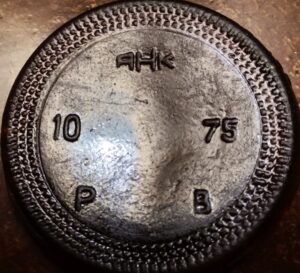
AHK (Alexander H. Kerr) mark on the base of an amber beer bottle shard dated 1975 - AHK (A H K)……………………Alexander H. Kerr & Company (see Kerr Glass Manufacturing Corporation), glass making plants at Altoona, Kansas (1909-1912); Sand Springs, Oklahoma (1912-1992); later plants at Huntington, West Virginia (1933-1983); Santa Ana, California (1943-1992); Plainfield, Illinois (1964-1996) and several other locations. Business offices were located in Los Angeles after 1919. The exact name of the Kerr company changed several times over the years. The first use of the AHK trademark by Kerr, according to U.S. Patent & Trademark Office records, was stated to have been on September 9, 1944. This mark was most commonly used on packer ware (jars, jugs and bottles for pre-packaged products sold at retail – such as mayonnaise, pickles, applesauce, coffee, etc.) as opposed to fruit jars for home canning. Most of the packer ware containers do not carry date codes so they can be harder to date than beverage bottles, such as soda and beer bottles which normally do bear date codes. The earliest beverage bottles I’ve seen with the AHK mark have “72” date codes. Julian Toulouse (Bottle Makers and their Marks, page 44) mentions the 1944 date, but also stated (in the same book) on page 544 that the AHK mark was used “since 1968” which seems contradictory. I believe he may have given that date in reference to when the first beverage bottles were marked with the AHK trademark? Or when Kerr acquired the former Whitall Tatum/Armstrong plant in Millville, New Jersey? For more detailed background info on Kerr and various marks used, see this article by Bill Lockhart et al: https://sha.org/bottle/pdffiles/KerrGlass.pdf
- Airko (on base of salt/pepper shakers)……………………… Airko Manufacturing Company, Clermont, Florida. This mark (often hard to read, and at a glance may be mistaken for Anko, Arko, Aiko or Aiiko) is seen on at least two styles of clear glass shakers. The most common type features horizontal raised rings or ribs encircling the shaker, similar in appearance to the Depression-era “Manhattan” pattern made by Anchor Hocking. Those shakers apparently date from the 1930s-1950s and their actual manufacture is attributed to Hazel Atlas Glass Company and/or Anchor Hocking (if you know which is correct, please let me know!). They were advertised as featuring a special design that helped keep the salt dry and free-flowing in humid weather. For an example of an advertisement, please see this page: https://chataboutdg.com/gallery/details.php?image_id=21647
- Aire & Calder Bottle Company…………… Aire & Calder Bottle Company, Castleford, Yorkshire, England (c.1836 – c.1913). This embossed marking is spelled out in a circular formation on the base of a dark olive-amber chemical/packer/utilitarian type bottle, probably dating from sometime in the 1855-1880 period. Also please see “A C B Co” entry.
- A. & J. ………………………….. A & J Manufacturing Company, Binghamton, New York. A&J specialized in manufacturing kitchen-related products such as mixers and egg beaters, and evidently the company had a business arrangement with Hazel Atlas Glass Co. to mark certain accompanying glass products. The most commonly seen item marked with those initials is a pitcher or large measuring cup that also served as the bottom container for a food mixer. That pitcher was patented in 1923. A & J was acquired by EKCO, of Chicago, IL, in 1929. Since those pitchers (in a medium green glass typical of Hazel Atlas during the Depression era) are fairly common and must have been made in large numbers, it is probable that many were made after 1929, continuing to carry the “A & J” marking after EKCO acquired the company.
- Albany Glass Works………… Albany Glass Works, Albany, New York (1847-1851). There WAS an earlier glass factory also called “Albany Glass Works” that existed near Albany (at Guilderland, NY) and that firm lasted from 1785 to 1815. But the bottles marked “Albany Glass Works” are from a later, unrelated company that bore a similar name. An iron-pontiled blob-top soda bottle in cobalt blue, and two types of historical flasks with the bust of Washington on them are lettered with this company name across the front, and those bottles evidently date between 1847 and 1851. HOWEVER, the great majority of flasks with this inscription found today are modern reproductions dating after the 1930s, with most having been produced up into the 1960s or 1970s or even later. If you have a flask with the marking “Albany Glass Works”, it is best to assume it is a repro until proven otherwise!
- A L R Co………………. unknown. These initials may stand for a distributing company. They are seen on the base of green glass floral containers which are similar to types marked “E.O. Brody Co.” and “Hoosier Glass”.
- Alton Glass Co………… Alton Glass Company, Alton, Illinois (c. 1871-1872). A handmade, applied lip coffin style whiskey flask is known which is marked across the front “MADE BY ALTON GLASS Co. / ALTON, ILL”. This company was evidently in business for about two years or less.
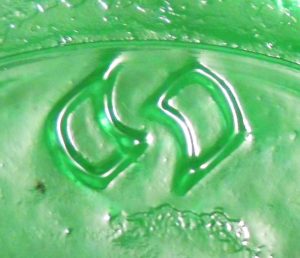
American National Can Company logo, on base of 1990 green soda bottle - American National Can Company (1987-2000) emblem. This particular logo was used from 1988 to 1995. The mark (shown in pic) is hard to classify, so I’ve pictured it on this page. This was photographed on the base of a typical emerald green non-returnable 16-ounce soda bottle with a 1992 date code. That type of bottle often contained a lemon-lime soda or ginger ale. Please also see a related mark, the “triangular logo” (which might be construed as a highly abstract “sailboat” representation) on page five.
- A.M.F.& CO……..Adelbert M. Foster & Company, Boston & Chicago (1893-1928). This was almost certainly a jobber / distributor, not an actual glass manufacturer. The mark appears on the bottom of druggist bottles. For more detailed info on A.M. Foster and related companies, see this article by Bill Lockhart et al: https://sha.org/bottle/pdffiles/AMFoster.pdf
- AMPAK ………………….. mark seen on base of clear whiskey flask, apparently of recent manufacture (c. 2000+). Ampak, based in Montreal, Quebec, Canada, maker/distributor of both glass and plastic containers.
- AM. TEL. & TEL. CO. (On glass telephone insulators)………………… American Telephone & Telegraph Company (formed in 1885), now known as “A T & T Corporation”, a subsidiary of parent company A T & T, Inc.. Most of the insulators marked with these initials are “toll” (long distance) style units. They were typically installed on long distance telephone lines that often ran alongside roads and highways connecting cities. That type is classed as “CD 121” in the Consolidated Design numbering and identification system used by insulator collectors. They were made by several glass manufacturers, including Hemingray Glass Company, Brookfield Glass Company, and others. These insulators date primarily from the 1895 to 1915 period.
- Anchor, or Anchor & chain (embossed design) on mouth-blown flasks……………….The pictorial representation of an anchor appears on many liquor flasks spanning (approximately) the 1830-1910 period, and many of these seem to be found in the general Baltimore, Maryland area. It is certain they were made by more than one glassmaker. Baltimore Glass Works certainly made some of them, and no doubt other glass companies in the Baltimore area also made them. The anchor may be placed either on the base, or on the front of the bottle. A variety of these would make an interesting collection in and of themselves.
- Anchorglass (one word)…………..trademark used by Anchor Hocking Glass Corporation. This mark dates from 1945 and was used into the 1950s or possibly later. Most items marked with this trademark have (or had) a foil label affixed, as opposed to permanent raised lettering (embossing) in the glass. Some Miller beer bottles in ruby red glass bear the word embossed on the bottom of the bottle. Please see my page on Anchor Hocking Glass Corporation.
- Anchor/H……………………….Anchor Hocking Glass Corporation.
- Anchor Hocking………………see Anchor Hocking Glass Corporation webpage (link above).
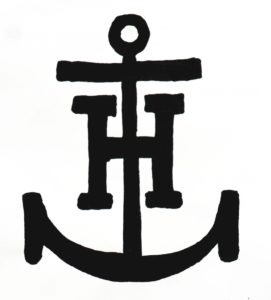
- Anchor and letter “H” entwined logo (shown)……..Anchor Hocking Glass Corporation, Lancaster, Ohio and other plant locations (1937-to date). For more information, see the link in entry below.
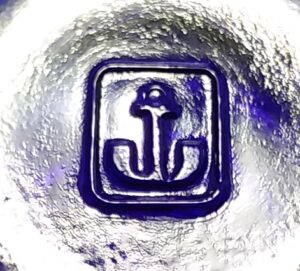
Anchor inside a rectangle or “Boxed anchor” mark used by Anchor Hocking ~ used from 1977 to c. 2000 or possibly later. Here on base of small cobalt blue dessert dish. - Anchor within a rectangle (shown above)…………..Anchor Hocking Glass Corporation, Lancaster, Ohio & other locations. (1937-to date). This mark used on their glassware since September of 1977. See Anchor Hocking Glass Corporation page.

Anchor Glass Container Corporation “Anchor” logo, this variation used from 1983 to 2014. - Anchor logo (pictured above – stylized angular “AG” letters, forming an anchor)……………..Anchor Glass Container Corporation, Tampa, Florida [head office], plants at Salem, NJ; Connellsville, PA; Winchester, IN; Shakopee, MN; Henryetta, OK; Jacksonville, FL; Elmira, NY; Warner-Robins, GA and Lawrenceburg, IN (1983-to date). (Anchor Glass Container Corporation was “spun off” from Anchor Hocking Corporation in 1983). AGCC has produced vast quantities of bottles and jars…………..liquor bottles, food containers, etc. This mark was used from 1983 to 2014. For some more info on this and related Anchor Hocking Glass marks, please check out this webpage on Anchor Hocking Glass Corporation.
- Anchor (inside vertical triangle with rounded corners, somewhat similar to a teardrop shape, shown below) – BSN Glasspack GmbH & Co. KG, Otto-Buchwitz-Straße 13, Bernsdorf, Germany (Deutschland). This mark is illustrated in a list of trademarks used by German glassmakers, published by Physikalisch-Technische Bundesanstalt (National Metrology Institute) in Germany, noted as active in 1971. Uncertain how long this mark was used, but I’ve seen it on the base of a green Jägermeister bottle that appears to date from the 1970s-1980s. The symbol is indistinct on some bottles and may look vaguely similar to a rock hammer, pickaxe, arrow, mattock or scythe.
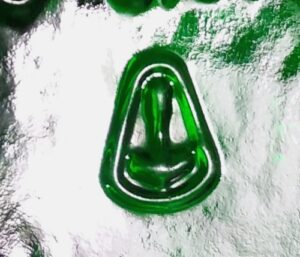
“Anchor or Pickaxe inside rounded triangle” mark used by BSN-Glasspack GmbH & Co, Bernsdorf, Germany. Photo shows the mark on the bottom of a green glass Jägermeister bottle. - Angel above Crown logo (shown below)………………………… Kerr Glass Manufacturing Company, Sand Springs, Oklahoma; Huntington, West Virginia; Santa Ana, California and other locations. This logo was used on the base of jelly glasses made by Kerr. I’m not sure about the exact time period it was used, but perhaps during the 1920s-1940s? Sometimes it is hard to be sure what the “angel” graphic is supposed to represent, although I would call it a “Winged Creature”. Dozens of different molds have been identified, each one with the image engraved a bit differently, since the engraving was done laboriously by hand on each mold. On some examples the figure has been characterized as a “bee” or some other type of winged insect.
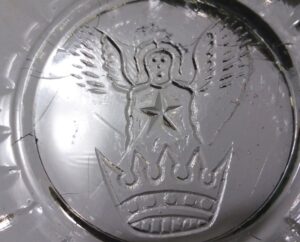
- Anko………….. see Airko.
- A O G CO …………………. uncertain meaning. These initials have been recorded on the bottom of at least three different bottles: a cylindrical generic chemical or druggist bottle; a rectangular colorless bottle lettered “Dr. Gunn’s Antiseptic – Made for Waco Electric Medicine Co / Waco, Texas” on the front; and a slug-plate type embossed druggist bottle from San Francisco. One possibility could be the “A. O. Goshorn Company” of Cincinnati, OH (a distributor of paint, glass, chemicals and other goods), but proof of any such connection remains elusive! The initials might stand for an obscure glass factory.
- A & P ………………. on the bases of Courtenay & Co. Worcestershire Sauce bottles, the initials stands for The Great Atlantic & Pacific Tea Company (the large chain of grocery stores). Although Courtenay & Company was based in Worcester, England, evidently their brand of sauce was marketed and sold for a long period of time by A&P in both Great Britain and the United States. The bottles thus marked are colorless (or nearly so) and were almost certainly made by an unidentified glassmaker in England. They generally appear to date from the 1880s to the 1920s period. Trade cards were published illustrating the product and the bottle, and many variations of those trade cards are known – bearing addresses of cities around the US, mainly Eastern and Midwestern locations, on the reverse of the cards.
- APG (as seen on base of small imported jar containing cocktail onions)………. APG Europe. Aluglas Packaging Group (based in Uithoorn, North Holland, Netherlands) merged with Verbeeck Packaging Group (based in Belgium) to form this company in 2017, specializing in a variety of glass and plastic containers, especially for the pharmaceutical industry, but for food and other products also.
- Arbogast & Co. Pitts. PA…………………Arbogast & Company (Alexander Arbogast), Pittsburgh, Pennsylvania (c. 1860-c.1863). See “A. Arbogast” entry. Obscure manufacturer that specialized in blackglass bottles. More detailed information on this operation (and many others) can be found in Glasshouses and Glass Manufacturers in the Pittsburgh Region 1795-1910 (2009) by Jay W. Hawkins.
- Arcoroc…………………………Brand name used by Arc International, France, for their commercial-grade glassware. See ARCOROC glass page.
- ARCYA Glass Corporation ………….. see the “AG mark” entry, above on this page.
- Ardagh Group (see U symbol, shown on page 5)
- Arko………………. see Airko.
- Armstrong (with a circle around the “A”, shown above)……………………………. Armstrong Cork Company, Glass Division. See “A in a circle”.
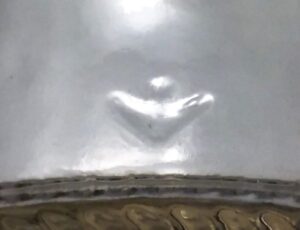
Anchor Glass Container Corporation stylized anchor or “downward pointing arrow” logo, introduced in 2014. Here on the lower heel of a clear Yoo-Hoo beverage bottle with 2022 date code. - Arrow (pointing downward)…………………….. Anchor Glass Container Corporation (1983-to date). Although this mark is another version of a “stylized anchor logo”, I would also characterize it as a “downward pointing arrow”. This is the most recent mark used by Anchor Glass Container on their glass bottles and jars, and typically appears on the lower heel area of the container. This mark was introduced in 2014. Anchor Glass Container Corporation is based in Tampa, FL (business headquarters) with 6 glass bottle manufacturing plants (as of 2019) located at: Shakopee, Minnesota; Lawrenceburg, Indiana; Elmira, New York; Henryetta, Oklahoma; Warner Robins, Georgia and Jacksonville, Florida. Two support locations (mold fabrication, equipment repair, etc) at Zanesville, Ohio and Streator, Illinois, were closed in 2018. For more info on this company and related companies, please see the “Anchor” marks, shown above, and my page on Anchor Hocking Glass Company.
- Arsenal Glassworks / Pitts PA ………. Arsenal Glass Works, Pittsburgh, PA (1865- c. 1869). The lettering embossed inside oval frame on lower front of figured flask, with eagle design on one side, and the image of a prospector, miner or traveler (with a “hobo stick” or bindle on his shoulder) on the reverse of the flask. The flasks are found in 3 different styles and are uncommon. (See also A. G. W.)
- Aseptic……………………….brand name seen on the base of clear druggist bottles. This line of druggist bottles was manufactured by Obear-Nester Glass Company, East St. Louis, Illinois (1894-1978). (See “N in a square” webpage). The ASEPTIC bottles might have been produced sometime in the 1917-1926 period. One example, marked “T. Ed Litt Drugs, Tucson, Ariz.” can be seen illustrated on page 105 of Michael R. Miller’s reference book “A Collector’s Guide to Arizona Bottles & Stoneware“(1999).
- A. T. & T. Co. (on telephone insulators)………….abbreviation for American Telephone & Telegraph Company. See AM TEL & TEL CO entry. The insulators with the marking “A. T. & T. Co.” were all made by Brookfield Glass Company, Brooklyn, NY.
- Atlas (on fruit jar)……….Atlas Glass Company, Washington, Pennsylvania (1896-1902), and the Hazel-Atlas Glass Company, Wheeling, West Virginia and other plant locations. (1902-1964). The ATLAS fruit jars were made in large numbers, with many minor variations, over a very long time.
- Atlas / H-A / Mason…………………..Hazel-Atlas Glass Company.
- Atterbury/Atterbury’s Patent June 30, 1863…………….(on fruit jars) Atterbury & Company (J.S. & T. B. Atterbury).

“AVON” embossed on base of black glass “Pot Belly Stove” men’s cologne bottle, circa 1970. - Avon…………………………Please see my webpage on Avon Bottles. A brief overview/discussion of Avon bottles including the glass figural bottles (such as the cars, etc) is presented there.
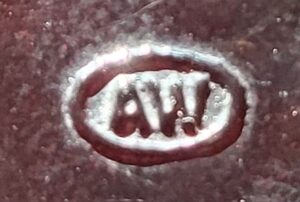
“AW inside an oval” logo, as seen on base of amber Orange Crush bottle with 1964 date code. (Photo courtesy of Jim Storm) - A W inside an oval………………………….. American-Wheaton Glass Corporation, Terre Haute, Indiana (c. 1960-c. 1964). Became American Can Company, Glass Products Division in 1963, that name lasting until about 1967, then operated by Midland Glass Company in 1968. Midland was based in Cliffwood, New Jersey but also operated plants at Shakopee, MN as well as the Terre Haute facility. The marks on actual bottle molds were not always changed (retooled) immediately so there is some date inconsistencies seen on actual bottle bases. Please see “A” stylized logo on this page also.
- A. & W. ……………… probably Agnews & Wilcox, Pittsburgh, Pennsylvania ( 1868-1872). Jay W. Hawkins (Glasshouses and Glass Manufacturers of the Pittsburgh Region 1795-1910) gives this date range and writes on page 20-21 that this mark is attributed to Agnews & Wilcox, who made coffin flasks and soda bottles among other containers. Also, a flask marked “Guaranteed Full Pint” posted on the antique-bottles.net discussion site bears “A & W” on the bottom, but that bottle appears to date from sometime in the period of 1895-1915 and likely stands for a later, unrelated and unidentified company.
- B (as seen on glass electrical insulators, NOT bottles)………… Brookfield Glass Company, Brooklyn, NY and Old Bridge, NJ. A single capital letter “B” appears on numerous “beehive style” (CD 145) glass telegraph line insulators, positioned immediately below the wire groove that encircles the insulator. The letter is often very faint, and easily overlooked. There may or may not be a mold or “shop” number or letter on the very top of the insulator. On these insulators, the “B” positively identifies the insulator to be a product of the Brookfield Glass Company (Bushwick Glass Works), and most of these beehive style insulators date from the c. 1900-1920 period. Although some of the “B” beehive insulators were made at their first factory location in Brooklyn, the great majority of these insulators (which tend to be in somewhat darker shades of aqua, teal and green) are believed to have been manufactured at their second plant at Old Bridge, New Jersey. Please see my page on the Brookfield Glass Company for more background information.
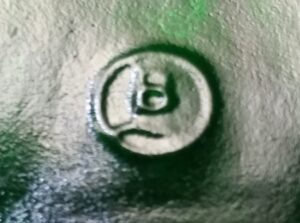
B with wavy underline, inside circle – Glashütten-Budenheim GmBH, Germany - B (with a wavy underline, inside circle)……………Glashütten Budenheim GmBH, Budenheim, Rhineland-Palatinate, Germany. This operation was formed in 1904 and glass bottle production was started in 1905 (making green champagne bottles in the very beginning). The company later became part of Gerresheimer Glass. This mark is illustrated with a line drawing in Toulouse (BM&TM, 1971-page 578), and stated to date from 1965. Uncertain how long the mark was used after 1965, perhaps into the 1980s? See photo of mark (above) as it appears on base of an emerald green Jagermeister bottle. That bottle is also marked “W. GERMANY” on base which would presumably date it before 1989.
- B (on certain handblown bottles, c.1910 or earlier)…………Uncertain. In some cases, perhaps Buck Glass Company. See next several entries. The letter “B”, in some cases, might be just a mold identifier letter, with no indication of the glassmaker.
- B (with 2 serifs)…………….sometimes Brockway Glass Company, Brockway, Pennsylvania (1907-1988). See “B in a circle“.
- B (with 2 serifs)………often the Chas. Boldt Company, (also at times known as Chas Boldt Glass Company or Chas Boldt Glass Manufacturing Company), Cincinnati, Ohio and Huntington, West Virginia, at least on many of their early liquor bottles and other ware made in the circa 1900-1919 period. NOTE : Manufacturer attributions of bottles with a “B” on the base are very confusing and (in my opinion) not completely certain. More information on the Chas. Boldt marks can be found here: https://www.sha.org/bottle/pdffiles/BoldtGlassCo_BLockhart.pdf.
- B (without serifs)………….in some cases, perhaps Buck Glass Company, Baltimore, Maryland (c.1909-1961). Buck Glass was sold to Knox Glass, Inc. in 1961.
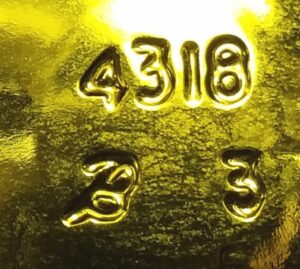
- B in cursive script (shown above)…………..Ball Glass Container Corporation, subsidiary of Ball Corporation. This mark used on some containers 1994-1995. See “BF”. See Ball Bros Glass Company.
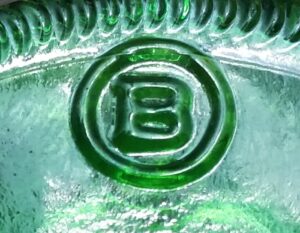
“B in a circle” trademark used by Brockway Glass Company, here on base of emerald green soda bottle. - B in a circle…………………..Brockway Machine Bottle Company (1907-1933) which became Brockway Glass Company (1933-1988), Brockway, Pennsylvania. This mark used from circa 1925 to 1988 or somewhat later (a bottle with a 1990 date code has been verified). The mark is very common and has been seen on innumerable bottles and jars of all types. For more information, please see my Brockway Glass Company / B in a circle webpage.
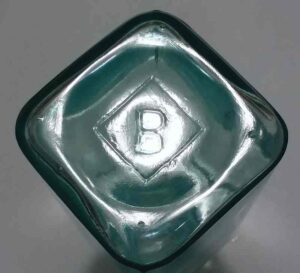
B inside a diamond ~ mark on the base of a blue-aqua horseradish or pickle bottle made by Binghamton Glass Company - B within a diamond (on the base of bottles, not tableware or novelty items, shown above) ………………………….. Binghamton Glass Company, Binghamton, New York (1880-1957). This mark has been verified on a few bottles. It likely dates from sometime in the 1880s-1910s period. For more information, please see this page: Binghamton Glass Company, Binghamton, NY. Also, see next entry.
- B within a diamond (as seen on colored ornamental and novelty glassware items such as small “hen on nest” dishes, toothpick holders, paperweights, salt cellars and figurines, but not utilitarian bottles)………………….. Boyd’s Crystal Art Glass, Cambridge, Ohio (1978-2014). Please see this page for more information: Boyd’s Crystal Art Glass
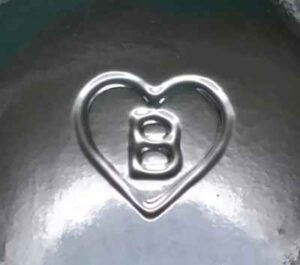
“B inside a heart” trademark used by Berlin Packaging, Chicago, Illinois. The mark is seen here on the base of a clear packer jar. - B inside a heart (seen on contemporary utilitarian packer jars)………………….Berlin Packaging L.L.C., corporation headquarters based in Chicago, Illinois (1988 to present). This company is a large supplier of glass, plastic and metal containers, with many distributing warehouses located worldwide. Berlin evidently wholesales the products of a number of glassmakers around the world, so the exact glass manufacturer (glass factory) that produced any particular container bearing this mark may not be easily identified. According to information on Justia.com, the “B in placed inside a heart” trademark has been in use by Berlin Packaging since June of 2016.
- B inside a triangle…….. Guernsey Glass Company, Cambridge, Ohio (1967-c.1988?)
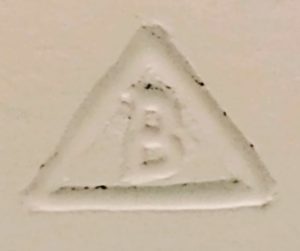
B in a triangle, as it appears on base of frosted light green rabbit dish made by Guernsey Glass Company (Photo courtesy of Deb Lane) Small hand-made operation, specializing in toothpick holders, open salts and other novelties in unusual colors. Only a small percentage of their product may have been marked with this logo. The “B in a triangle” stands for Harold Bennett, proprietor of the glass firm. Reportedly, the molds used were eventually sold to several other glass companies, including Mosser and Wilkerson.
- BA 2 (interspersed with various mold numbers and other codes, as seen on bases of ten-sided Bonne Maman brand preserve and jelly jars) …………. B A Vidro (B A Group or B A Glass) , based in Avintes, Portugal, the “2” indicating production at Marinha Grande, Portugal (1912-to date). B A (originally Barbosa e Almeida) has a long history of glass production with various mergers and acquisitions over the years, now owning/controlling glass factories in Portugal, Spain, Germany, Poland, Romania, Bulgaria, and Greece. According to the Bucher Emhart punt mark database, they use various plant numbers (from “1” to “12”) positioned to the right of the “B A” to identify various manufacturing locations, as shown in the database here: https://emhartglass.com/sites/default/files/publications/2020-10/BR0068%20-%20BEG%20Punt%20Marks%20Guide.pdf . According to their website, BA Glass now exports glass containers to about 80 countries worldwide. A history / outline of the company is here at this webpage: https://www.baglass.com/en/history.php
- Ball……………………Ball Brothers Glass Manufacturing Company/Ball Brothers Company (Ball Corporation after 1969), Muncie, Indiana and other locations (1888-1998) . Please see Ball Bros Glass Manufacturing Company page for a brief summary of this company.
- Ball Bro’s Glass Mf’G Co. Buffalo…………Ball Brothers Glass Manufacturing Company, Buffalo, NY (marking seen on glass fruit jar lids made c. 1885-1888). See Ball webpage for summary of this company.
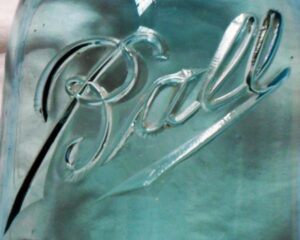
“BALL” logo, as seen on a BALL PERFECT MASON jar from the period c. 1910-1923. The exact cursive style changed slightly several times over the years. - Ball Perfect Mason…………….see this page with a brief summary of this popular jar, as well as Ball Bros Glass Manufacturing Company page.
- Baltimore Glass Works………………..Baltimore Glass Works, Baltimore, Maryland (c.1800-1905, which includes a succession of firms). Various flasks and bottles are marked with the full factory name, and the majority of these probably date between 1830 and 1870. Also, see B.B. & Co.
- B.& A.C.CO…………Baker & Adamson Chemical Company (1881-1913). Producer of acids and other chemicals. Although not the mark of a glass factory, this may be mistaken for one. Seen on the base of chemical and acid jars and bottles, most of which probably date from the early period — 1881 to 1900. B&A was bought by General Chemical in 1900, and in 1913 General became a division of Allied Chemical & Dye Corporation, later Allied Chemical Corp. ACC merged into Allied-Signal and that company is now part of Honeywell, Inc.
- BANNER …………………… trademark used by Obear-Nester Glass Company, East St. Louis, Illinois (1894-1978), for one of their lines of druggist bottles. Confirmed on the base of a clear rectangular pharmaceutical/prescription bottle. According to Arthur G. Peterson’s “400 Trademarks on Glass” this was used beginning in 1899. No information on ending date.
- “Belt Buckle” logo (oval shape with line through center) ……….Western Glass Manufacturing Company, Valverde (Denver), Colorado (c.1900-1909).
- B B (0n American-made bottles)………………..Berney-Bond Glass Company (1905-1930), see entry under “B B G CO”.
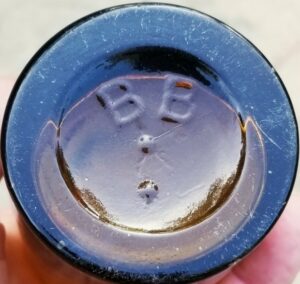
BB on base of unidentified applied-lip yellow olive amber mineral or soda water bottle, probably from Great Britain. There is no embossing on the sides of the bottle. (Photo courtesy of Jimmy Bray). - B B (as seen on base of “generic” yellow olive amber mineral water or soda bottle with applied lip, probably of British origin)……………………..unidentified with certainty, but this mark might stand for Bateson Brothers, Liverpool, England. The Bateson Brothers glassworks operated for many years from the late nineteenth century and well into the 20th century. (Thanks to Jimmy Bray for the photo, and Sandi Ratch for her help with research info).
- BB48…………….Berney-Bond Glass Company (1905-1930), see entry under “B B G CO”. NOTE: Milk bottles bearing the mark “BB48” were also made by Owens-Illinois Glass Company for many years after Berney-Bond was no longer in existence. In cases such as this, the Owens-Illinois mark (diamond superimposed with O and I) will also be seen on the base. Most of the bottles carrying both of these marks were made at the former Berney-Bond glass plant at Clarion, PA, which became O-I plant number 17. I am not sure how late the BB48 mark was retained on Owens-Illinois milk bottles made at this plant, but have seen a bottle with a 1947 date code.
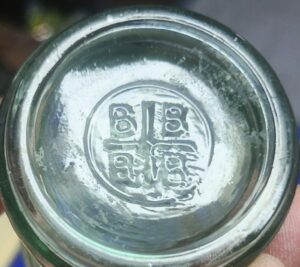
BBBB logo on base of light green-aqua ink bottle (Photo courtesy of Paul McClure) - BBBB / B B B B (Cross or “Plus” sign (+) with four letter “B”s – one letter placed in each quadrant)…………………….. Unknown / unidentified (shown here). This mark has been seen on the base of a few handmade ink bottles, possibly made in Great Britain sometime in the late 1800s or early 1900s. If you know what this mark stands for, please let us know!
- B B CO……………in most cases, probably Bell Bottle Company, Fairmount, Indiana (c. 1913-1915). Bell Bottle made milk bottles, so if the mark is on a milk bottle, Bell is the most likely source. Other possibilities include Berney-Bond Glass Company (1905-1930, see B.B. G. Co. entry below), and Bellaire Bottle Company, Bellaire, Ohio (c.1885-1921+). The “B B Co” or “BB Co” initials are also sometimes seen on the front of some beer bottles and other types of unrelated bottles and in those cases the initials don’t pertain to a glass manufacturer.
- B. B. & Co. ……………… Baker Bros. & Company (proprietors of the Baltimore Glass Works), Baltimore, Maryland (1852-1905). Mark seen on the base of Baltimore-area aqua blob beer bottles from the c. 1880-1895 period. (Thanks to Greg Franklin for supplying info on this mark!)
- B B G CO………….Berney-Bond Glass Company (1905-1930). A merger of the Bond Glass and Berney Glass companies, plants were located in Bradford, Hazel Hurst, Smethport, Clarion, and Knox, all in the state of Pennsylvania; the Winslow Glass Co. plant at Columbus, Ohio was purchased in 1927. Berney-Bond was bought by Owens-Illinois in 1930. Most of these plants were closed down in later years, until by the early 1970s only the Clarion plant (Owens-Illinois plant #17) was still making bottles.
- BBGMCO (monogram on jars)……..Ball Brothers Glass Manufacturing Company, Buffalo, New York (used on fruit jars c.1886-1888 before move to Muncie, IN.) See “Ball”.
- B-C …………Bartlett-Collins Glass Company, Sapulpa, Oklahoma (1914-1929); Bartlett-Collins Company (1929-2008). B-C mark (the letters enclosed in conjoined circles) was used on tumblers after 1921, but I do not know how long after that the mark was used. Manufacturer of a wide line of tableware over the years, Barlett-Collins was later a subsidiary of the Lancaster Colony Corporation (owner of Indiana Glass Company after 1957). Bartlett-Collins produced items such as jars, mugs, canisters and votive candle holders under the brand name “Indiana Glass”. The Bartlett-Collins plant was eventually purchased by Anchor Hocking Company, and shortly thereafter closed down (as of June 2008). Items made there during the Lancaster Colony Corporation years, in general, do not carry an embossed maker’s mark. A sister plant operated by Lancaster, located at Dunkirk, Indiana (the original “Indiana Glass Company” factory) ceased production of glass in 2002. See “Indiana Glass” and “LCC” marks. For much more detailed info on Bartlett-Collins and the history of the Premium Glass Company and other organizations involved in the earlier history of the plant, see this article written by Bill Lockhart et al: https://www.sha.org/bottle/pdffiles/BartlettCollins.pdf
- B & Co [o is underlined], below a triangle…………….. Uncertain, but possibly Bagley & Company, Knottingsley , England (see next entry). Triangle has number “500” embossed within, on the example reported, but perhaps a different number appears on other containers? Handblown, odd lip jar, off-clear glass w/perhaps faint grey-amethyst tint. (Reported by Sam Lawson).
- B & Co ; B & Co Ld ; B & Co Ltd……………………. Bagley & Company, Knottingsley, Yorkshire, England (1871-c. 1960s) . All three variations of the mark have been observed, and are believed to be from the 1890s-1920s period. They are seen on various pickle bottles and other condiment/food bottles. Bagley & Company Limited was incorporated as such in 1898 so the marks that include the “LD” or “LTD” presumably date after that year. For more background information on this glass company, please see Bill Lockhart’s article at this URL: https://sha.org/bottle/pdffiles/Bagley&Co.pdf
ADVERTISEMENT
- Bee (insect, an image of a bee with the letters “H” in left wing, “I” on body and “G” on right wing)…………………………………John B. Higbee Glass Company, Bridgeville, Pennsylvania (1907-1918). Seen on pressed glass tableware and novelties, most commonly in clear glass. NOTE: this mark, or a very similar mark, has also been embossed on reproductions made by other glass companies in later years, although in those cases the “Bee” is said to have no letters visible. I would strongly recommend more in-depth research on Higbee and the glass they made before attributing a particular item to that glass factory.
- BF……………….Ball-Foster Corporation (mark used 1995-2000). In 2000 became Saint-Gobain Containers, with the SG mark being instituted. See Ball Bros Glass Company.
- B.F.G.CO………………….Beaver Flint Glass Company, Toronto, Ontario, Canada (1896-1939). Maker of druggist, nursing, and other medicine bottles in clear and cobalt blue glass, mostly found in Canada. The Beaver Flint Glass Co. was evidently primarily a jobber, not an actual bottle manufacturer, and probably sold ware made by Diamond Flint Glass Company, Diamond Glass Company and later Dominion Glass Company in Canada. Also, see next entry.
- B.F.G.Co…………………. Beaver Falls Glass Company, Beaver Falls, Pennsylvania (1869-1879). This mark is seen on a few early telegraph insulators (all rather uncommon) as well as on certain blob top soda/mineral water bottles of the 1870s. Of course, this company had no connection whatever with the Canadian firm mentioned in above entry. Here’s an article listing the various types of insulators attributed to Beaver Falls Glass Co: https://www.insulators.info/articles/beaver.htm
- B.G.CO……………this mark was used by a number of different companies, and there is still uncertainty on absolute attribution in many cases. On earlier blob-top “export style” beer bottles and soda bottles, usually Belleville Glass Company, Belleville, Illinois (1882-1886). The Belleville factory was purchased by Adolphus Busch Glass Manufacturing Co. in 1886, and presumably the B G CO mark was discontinued soon after, being replaced by A.B.G.CO. or A.B.G.M.CO. The “B.G.Co.” mark was also used by Burlington Glass Works, Hamilton, Ontario, Canada (1875-1909) on the face of their “Burlington” fruit jars. A Moxie soda bottle variant with a crown lip carries the B.G.CO. mark, and in that case would have been made by an unidentified factory some time after 1892 (the year the “crown” style lip was introduced). “B.G.CO.” is also reported on the heel of a light green crown lip Anheuser-Busch Brewing Association beer bottle that appears to date from the 1910s or 1920s. The maker is uncertain. On some milk bottles, B. G. CO. was apparently used by Buck Glass Company, Baltimore, Maryland. (Buck normally used just a “B”). Binghamton Glass Company, Binghamton, NY (which used a “B in a diamond” mark on a few bottles) is another possibility in some cases, although there is no proof of this. If you have information that could shed more light on the BGCO marks, please contact me.
- B G W (on the side of a “fat” dip mold ale or stout bottle, possibly c. 1800-1830, found in the Baltimore, MD area) ……………………….. Uncertain meaning, but it is possible the initials, in this particular case, stood for the Baltimore Glass Works. See this webpage: https://bottleden.com/frederick2.shtml (Also, see “Baltimore Glass Works” above, also next entry).
- B G W……………… this mark was almost certainly used by Bushwick Glass Works, Brooklyn, New York (1864-c.1912) on a few soda and beer bottles: An aqua blob-top soda bottle marked “Minck Bros. & Co / Brooklyn” is known with B G W on the base along with a mold number (thanks to researcher Lee Brewer) . The mark has also been reported on a few other handblown beer bottles from towns in the state of New York, including bottles marked “James A. Holmes, Auburn, N Y” and “D. LaGrange, Moravia, N. Y.”. The mark may or may not include periods after each letter. Bushwick Glass Works is better known as Brookfield Glass Company. A similar mark might also have been used in a few cases by Binghamton Glass Works/Company, Binghamton, New York (1880-1957), but there is currently no concrete proof, as far as I know, for that company’s use of the mark. For more background info, check out this article by Bill Lockhart et al: https://sha.org/bottle/pdffiles/BinghamtonGCo.pdf ALSO: There is no solid evidence that Burlington Glass Works/Company (of Hamilton, Ontario, Canada) ever used the letters “B G W” on any glass they produced. (That belief was probably started by Julian Toulouse in “Bottle Makers and their Marks”, stating it was used from 1875-1877). If you have evidence that would indicate otherwise, please let me know.
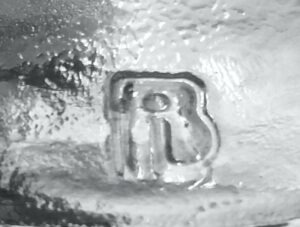
Ball-InCon Glass Packaging Corporation (mark used 1987-1994) - BI (or “I B”, a stylized logo/monogram consisting of “B” with lower-case dotted letter “I” incorporated within the letter “B”)……………………Ball-InCon Glass Packaging Corporation (mark used 1987-1994). Ball-Incon was formed as a merger of the glass plants owned by Ball Corporation, combined with the Indianhead Container Corp which consisted of glass plants at Laurens, SC (the Laurens Glass Works plant); Port Allegany, PA; Madera, CA and other locations. See Ball Bros Glass Company.
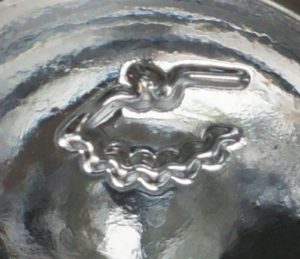
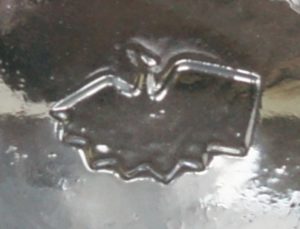

- Bird in flight logo or emblem (shown)………………….. three logos were used by Phoenix Packaging, based in Montreal, Quebec, Canada (1980- to date). A reader of this page, Dawn High, who was trying to find the user of one of these “bird logos” as it appeared on the base of an olive oil bottle/cruet, introduced me to this (formerly unidentified) mark. Now, thanks to Joel B. Miller, more info can now be published revealing the user of these marks! Two “older” logos (both with a more “horizontal” look) were used from approximately 1980 to 2014. Their third bird logo (with a somewhat more “vertically oriented” design) is currently in use, introduced on new molds in 2014. Phoenix Packaging contracts with many customers around the world to have special glass container designs produced to their specifications. Many different glass bottles and jars have been made, as well as packaging in other mediums such as ceramic, plastic, wood, metal, etc. Several dozen glass manufacturers have been involved at some time over the last few decades, including well-known glass container firms such as O-I and Verallia. (Thanks very much to Joel B. Miller for info and photos of those logos shown here).
- BiXby………………… S. M. Bixby & Company, New York, New York. (1862-19?). For a brief summary of this company, see this page: S. M. Bixby Company Bottles.
- Blenko Handcraft (usually seen on paper or foil labels) ………………………….. Blenko Glass Company (began 1893, later, at Milton, West Virginia since 1921). Maker of beautiful hand-made blown glass in a wide range of bright colors; the most popular item ever produced would be their widely-recognized “Water Bottle” with a very characteristic shape. This bottle has been made in many, many colors since 1938. A wide variety of handmade items are produced, some of them from hand-carved wooden molds as well as iron molds. Very few Blenko glass articles were marked (in the glass itself), but here is a page with more info on various Blenko glass marks and labels: http://www.blenkocollectors.com/blenkocollmarks.htm The official Blenko Glass Company website is here: http://www.blenko.com
- B. L. Fahnstock Fortune & Co. Pitts. Pa. ……………..Fahnstock, Fortune & Company, Pittsburgh, Pennsylvania (1866-1873). Mark seen on the base of wax sealer and “Kline stopper” type fruit jars. This company was evidently sold to Evans, Sell & Company in 1873. See “F. A. & Co” and “E. S. & CO.” marks.
- BLUE RIBBON…………………. Standard Glass Company, Marion, Indiana (1906-1933). Trademark is found embossed on the bottom of their line of clear (“flint”) rectangular druggist/drugstore/pharmacy/prescription bottles. The bottles are found in a range of sizes, and either “plain” (unlettered), or with a “plate mold” embossing – bearing personalized raised lettering for a local druggist, often with street address, city and state. This “Blue Ribbon” trademark was first used in 1908, according to information published in Arthur G. Peterson’s 400 Trademarks on Glass (1968). Standard Glass Company was bought by Foster-Forbes Glass Company in 1933.
- B. M. & Co. ………………….. Benton, Myers & Company, Cleveland, Ohio (c. 1876-c. 1904). This mark appears boldly embossed on the bottom of a mouthblown, applied lip “ginger oval” or bluing type bottle in light aqua glass. That bottle is a standard “generic” type with embossing only on the base, and the example bears a paper label for “Dr. Frazier’s Root Bitters” which was an obscure brand of bitters from Cleveland. The bottle itself was made by an unidentified glassworks, likely of 1870s or 1880s vintage. The mark has also been seen on the front of two variations of clear “turtle” style baby nursing bottles from the 1880s – one type has the B M & Co lettering placed inside an eight-pointed star, and another one with the lettering inside a diamond. Benton, Myers & Company, apparently a longtime wholesale jobber of drugs, liquor and other items, was previously named “Benton, Myers & Canfield” – at least as early as 1864, possibly earlier.
- B.& M.S.Co……….Bottler’s & Manufacturer’s Supply Company, Long Island City, NY (c.1897-1920). Seen on heel of New York City-area blob beer bottles.
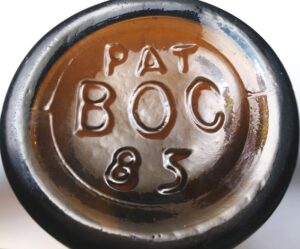
Unidentified B O C mark on base of amber handmade beer bottle - B O C……………..Unknown (Seen on base of amber quart “blob lip” beer bottle, c. 1885, shown here in pic). Although it has been proposed by some researchers that this mark is merely a mold-cutting error for “D.O.C.” (see that entry), I am doubtful and believe that this actually does stand for an obscure, short-lived glass company (or bottling or brewing firm) with those corresponding initials. The embossed lettering is very strong and bold on this bottle. If anyone comes across a bottle with the “B O C” mark on the base, I would love to hear from you. If the location of finds can be noted, this might give us clues pointing to the area (city, state) where these bottles were most likely made.
- BODE……………..Bode Extract Company, Chicago, Illinois (Gustav Augustus Bode, proprietor). Mark seen on the heel of a few hutch soda bottles. Bode evidently manufactured bottles from c. 1890 to 1892, but thereafter concentrated on the production of extracts. He passed away in 1900. Thanks to Joel Ferguson for sending me this info!
- Boldt………………. Chas Boldt Glass Company, Cincinnati, OH and Huntington, WV (1900-1926). For much more detailed info on the various marks used by this company, see this webpage: https://sha.org/bottle/pdffiles/CharlesBoldt.pdf
- Bottle (upside-down bottle superimposed over a capital G)………………….. Graham Glass Company, Evansville, Indiana . This mark was introduced in about 1913. See “Graham”.
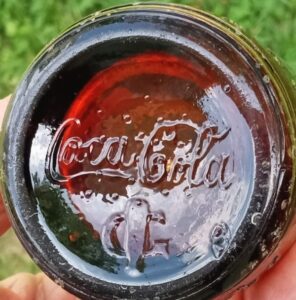
Upside down bottle superimposed over capital G, as seen on amber Coca Cola bottle (photo courtesy of Clifford Campbell). - Bottle inside an oval (embossed design/emblem showing a bottle inside an oval, seen on the base of green “Ten Pin” or bowling pin style soda or mineral water bottles which appear to be of British origin)…………….unknown meaning, but presumably the mark of an unidentified glass bottle manufacturer from Great Britain. Please see this webpage: Bottle within an oval mark.
- Boyd’s Crystal Art Glass, Cambridge, Ohio . (B in a diamond mark on upscale glassware indicates that company.)
- Boyd’s Genuine Porcelain Lined Cap (or ‘Genuine Boyd Cap for Mason Jars’, other variations)………. marking seen on white milkglass inserts (discs or lids) used with zinc lids on “Mason” type fruit jars. Please see this page for more information.
- B. P. & B…………………Bakewell, Page & Bakewell, Pittsburgh, Pennsylvania (1824-1836)
- B.P.CO……………Brunswick Pharmacal Company, New Brunswick, New Jersey. Seen on small cobalt medicinal bottles, dating perhaps from about 1895-1930. Bottles are also marked with a “back-to-back PP” inside a circle. Actual glass manufacturer is unknown, but Maryland Glass Corporation, Baltimore, MD (a prolific maker of cobalt blue bottles after 1907) could be one possibility. The “B.P.CO.” marking bears no relationship to the next entry.
- B.P.& Co………Beck, Phillips & Company, Pittsburgh, Pennsylvania (c.1866-1886+). Seen on the base of wax sealer fruit jars. Some similar jars are also found lettered “Beck, Phillips & Co. Pitts. Pa” in a circle on the base. McKearin (1941:611) indicates this company changed its name to “Phillips & Company” in 1874, and was still operating in 1886. The actual ending date was not given. So presumably the jars found with either of these marks would date between about 1866 and 1874.
- Bridgeton Glass Works …………… Bridgeton Glass Works, Bridgeton, New Jersey (c. 1855-c.1870) . The full factory name is spelled out across the face of several known soda bottles. This glass factory operated under the ownership of at least three or four different business firms during it’s long history, including J. Bodine & Sons. The bottles with the actual “Bridgeton Glass Works” embossing are generally believed to date from the 1855-1870 period, but it’s possible some bottles with that marking might date somewhat earlier.
- Brockway……………..Brockway Glass Company, Brockway, Pennsylvania (1907-1988). See “B in a circle” page. Most bottles I have seen with the cursive “Brockway” marking, usually embossed on the base, appear to date from the 1950s-1970s period, although I don’t know the exact period of use of this mark.
- Brody (E. O. Brody Co)………………… E.O. Brody Company, Cleveland, Ohio (1958-to date). This is not a glass company, but a distributor of products made especially for the florist industry. For more information please check out this page: E. O. Brody Company.
- Bromo-Seltzer / Emerson Drug Co. / Baltimore, MD. (usually embossed across the face of the bottle)………………………. Bromo-Seltzer was an extremely popular drug, in the form of a powder, introduced circa 1891. For more information, please see the Bromo Seltzer page.
- Brookfield (On glass electrical insulators, shown at right)…………………. Brookfield Glass Company (1864-1921) with factories at Brooklyn, New York and Old Bridge, New Jersey. For more information, see Bushwick Glass Works (Brookfield Glass Company) page.
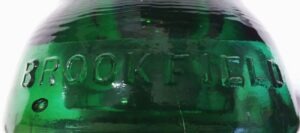
“BROOKFIELD” embossed on skirt of emerald green CD 152 style telegraph line insulator made by Brookfield Glass Company at Old Bridge, New Jersey - Brookfield (On milk bottles)………………… See this page on the Brookfield “Baby Face” milk bottles.
- Brooklyn Glass Bottle Works………………..Brooklyn Glass Bottle Works, Brooklyn, New York. Time period when this plant was in operation is uncertain. From the type and general style of bottle which carries the mark (early cylinder whiskey), it looks like the company was probably in operation during the 1860s or 1870s.
- Brooklyn Glass & Mfg. Co …………………….. Brooklyn Glass & Manufacturing Company, Brooklyn, NY (c. 1897-c. 1899). An amber strap-side liquor flask is known with the marking “BROOKLYN GLASS & MFG CO / 338 B’WAY / BROOKLYN NY” embossed on the base. This seems to be a very scarce mark and I have not seen another bottle with this lettering on it. This firm appears to have been in operation much later than – and probably had to relation to – the “Brooklyn Glass Bottle Works” noted above.
- Brownie (B in a circle, followed by “rownie” in cursive script)…………………. “Brownie” was the brand name given to a line of early “No Deposit / No Return” beer bottles made by
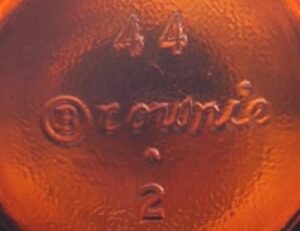
Base of amber Brockway Glass Company “Brownie” beer bottle with 1944 date code (Photo courtesy of Dan) Brockway Glass Company (see “B in a circle”). They appear to date from the mid- 1940s. A brief mention of these bottles is made in this article about early Non-Returnable type beer bottles: https://sha.org/bottle/pdffiles/NRBeers.pdf . This particular brand name has nothing to do with the ACL “Brownie” brand soda bottles.
- B & S …………….unidentified with certainty. Seen on base of pickle or “chow chow” bottle, probably from Great Britain. A possibility would be Thomas Barron & Sons, an obscure bottle maker operating circa early 1890s. The initials are also found on the bottom of some Worcestershire Sauce bottles, also indicating an English origin.
- B. T. & Co. (on the base of “Mason’s Patent Nov 30TH 1858” style fruit jars)……….. Bodine, Thomas & Company, Williamstown, Pennsylvania (c. 1864-c. 1891). Most of the Nov 30TH 1858-type jars with these initials on the base were probably manufactured in the 1864-1867 period. The factory was known as the Williamstown Glass Works. For more info on the Bodine firms and the marks they used, see this .pdf file article by Bill Lockhart et al: https://sha.org/bottle/pdffiles/Bodine.pdf
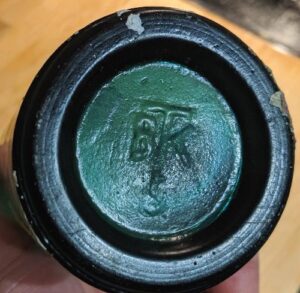
BTK marking on base of teal aqua-green bottle (photo courtesy of Eric Hulten) - BTK monogram (shown) ……………… This mark, which might also be read as “TBK” or “BKT”, shown at right, appears on the base of a crown-lip style soda, beer or mineral water bottle (of an “Apollinarus” style) of a rather dark teal/aquamarine glass, found by Eric Hulten when diving off the coast of Guam. [Update 2/11/2023] – archeologist Nina Peck reported a similar bottle also found on Guam – during excavation for utility lines – and she was able to contact a retired professor and glass manufacturing industry researcher named Mr. Shoji, (庄司太一) of Tokyo, who relayed that the mark almost certainly stands for the Kirin Brewery Company’s Tonda glass bottle manufacturing plant, located in Suotonda-cho, Shinnanyo, Shunan City, Yamaguchi Prefecture, Japan. According to one website (kirinholdings.com), the Tonda bottle plant was started in 1938. That bottle factory was sold to KYC Corporation in 1992. (Thank you to Nina Peck for your kind help with this mark!!)
- Bumps (dots or bumps on the base of containers)………. please see my entry under “Dots” on Page Two.
- Burgin & Sons………………………… Philadelphia Glass Works, Philadelphia, Pennsylvania. See “Philada Glass Works”.
- Burnett’s Cocoaine………………….. This was actually a hair dressing made with Coconut Oil, promoted as a product guaranteed to give the hair a more luxurious, healthy appearance. Contrary to what some collectors might assume upon finding a bottle with this embossing, the product did not contain cocaine (unlike some of the products being sold in the mid and late 1800s that did indeed contain that ingredient). First sold in 1857 by Joseph Burnett of Southborough, Massachusetts, it was a popular product for many years and was still available into the early 20th century. Several variations of the bottles exist. The glassmaker is uncertain, but it is probable that one or more bottle companies located within or near the Boston area manufactured these bottles. This webpage from the Southborough Historical Society has some information on Joseph Burnett: Joseph Burnett Chronological History.
- Bushwick Glass Works…………….Bushwick Glass Works, Brooklyn, New York (1864-c.1912). More commonly known under the name Brookfield Glass Company. Prolific maker of glass electrical insulators, they also made large quantities of bottles and jars, the great majority of which were not marked with the company name. See my webpage with more info here: Brookfield Glass Company .
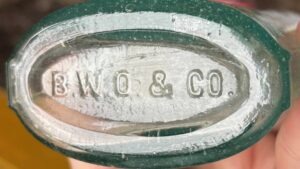
“B. W. O. & CO.” on base of handmade light aqua strap side flask – initials indicating B.W. O’Neil & Company, Boston, MA. This was a jobber, not an actual glass manufacturer. (Photo courtesy of Crystal King). - B. W. O. & CO. ……………….. B. W. O’Neil & Company, Boston, Massachusetts (c. 1882- c. 1918). Initials seen on the base of strap side style liquor flasks. Although this firm claimed to manufacture glass, it was actually a distributor / jobber of glassware, bottles, tumblers, druggist’s items, etc. So the actual glassmaker of bottles with this marking is uncertain. See a 1911 ad for the company on this article by Bill Lockhart et al: https://sha.org/bottle/pdffiles/BOther.pdf
- B superimposed over W (or W superimposed over B)……… Uncertain. See “W superimposed over B” entry on page 5 (S-Z marks).
- B & W (along heel, on scarce early pictorial eagle flask)……….. possibly Burgin & Wood, Millville, NJ (c. 1827-1829)
- B & W (on base of amber whiskey flask, circa 1890-1915, no connection to mark above) ……………….. uncertain meaning.
- B Z (Letter “B” positioned above a larger “Z”, on the base of glass paperweights)………….. Zimmerman Art Glass Company, Corydon, Indiana (1963-to present). This particular mark indicates a piece made by Bart Zimmerman (one of two sons of owner Joseph Zimmerman) who joined the company in 1983. Tragically, in August of 2008, Bart (along with another victim) drowned in an attempt to help rescue some fishermen whose boat had overturned in a boating accident on the Ohio River below Cannelton Dam. Also, see “K Z” and “Z” entries.
[ A – B ] [ C – D ] [ E – L ] [ M – R ] [ S – Z ]
Please click here to go to my website Home Page.
ADVERTISEMENT

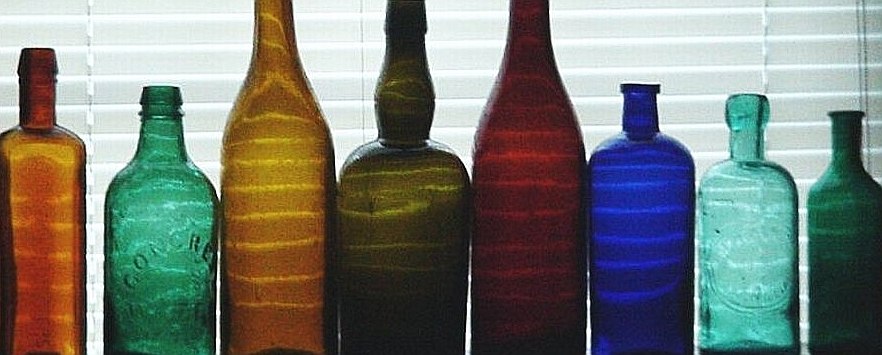
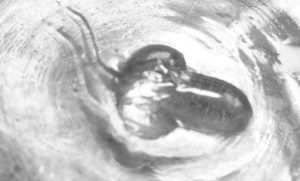
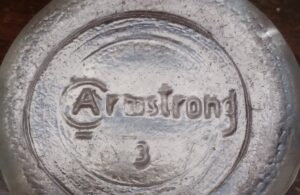
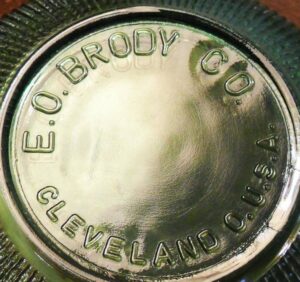
I found an AB&Co black glass bottle base in the flood plain of Coyote Creek, San Jose California
Andrew, thanks for your post! That’s one of those unidentified marks seen on old black glass bottles likely made in Great Britain. Hopefully, eventually some one will discover the identity of that glass maker!
~David
Hello Sir,
Yesterday I purchased three jars, two have the faint original Owens-Illinois “Diamond & oval with I in middle” trademark as shown at the top of this page. On the left of the trade mark looks to be a 21 OR 23 with a 5 on the right side. Through research I found a pdf showing the plant locations. I’m thinking the “21” is for San Francisco, CA between 1932-1937 or “23 is for Los Angeles, CA from1932-present. I’m also thinking the “5” is for 1935 then they changed the date code to two digits ? The bottom of these jars are also embossed “IRIS COFFEE” above with “HAAS BARUGH & CO.” Through research I found that “IRIS Coffee jar produced for the Haas Baruch & Company in Los Angeles no later than 1953. After that time, Smart and Final purchased this company and the coffee was no longer stamped on the bottom as Haas Baruch & Company.” My problem is on one side of these jars is embossed 2-1984. The third jar has the embossed “IRIS COFFEE” above with “HAAS BARUGH & CO.” a different makers mark (maybe a ribbon inside a circle) and the faint numbers to the left and right with faint numbers above but without the 2-1984 on the side.
Hi Roger,
I was looking through a number of past ebay auction listings of Iris Coffee jars that are indexed on the Worthpoint site database, and (judging by some of the listings in which the seller included base photos) found that nearly all of those jars bear the “23” plant location code which, yes, indicates production at the O-I Los Angeles factory. Some jars had other single digit numbers placed to the right including “2”, “3” and “5”. Yes, the “5” would certainly stand for 1935.
In the 1940s, Owens-Illinois switched to 2-digit date codes, although there are many exceptions and that can only be considered a “general rule”. Many, many smaller bottles continued to carry one-digit date codes even after the 1940s if there was little room on the base of the bottle.
In any case, the “2-1984” would be just a code number that identified that particular mold or mold design. Evidently a number of molds were used over several years’ time for production of those jars. That brand of coffee was evidently quite popular in California for some time in the early to mid-20th century. For instance I saw another jar on Worthpoint that was marked “1986-C”. There are probably others to be found. The number would have had significance within the factory at the time, but has little relevant meaning to us today. Of course, since these jars were made in the 1930s, the resemblance to a more recent date (like “1984”) is purely coincidental. Thanks for your post!
David
No need to reply. Just a quick note of appreciation for your vast and comprehensive site; the most powerful of all research sites for antique and vintage glass containers. Having worked at Fairmount Glass Works in the early sixties, along with my father, my two brothers, two brothers-in-law and other relatives (and having been there when John Harkness and Cedric Rau and other glass-making “historical’ s glassmaking pioneers or their descendants were still part of the company), I nowadays deeply enjoy looking for old glass containers to be found in ancient trashpiles, etc. and using your site to identify my finds. Thank you for this unique and important site.
David Templeton
Maryville, Tennessee
Hi David, thank you very much for your kind words! I’m glad you found this site to be useful!
Take care, David
Salt and pepper shakers with a B and ◇ around the B. Can you tell me who made them and when
Hi Stephanie,
Please check out my webpage on Boyd’s Crystal Art Glass Company – at this link: Boyd’s Crystal Art Glass: B in a diamond mark on glassware. Hope this helps a little!
David
I found a vintage whiskey bottle in the wilderness here in west coast Canada.
It is clear and flat with a distinct stamp on the bottom. It has a diamond shape with a D in the centre. I’m wondering who made it and how old it is. Thank you!
Hello Luanna,
The “D inside a diamond” stands for the Dominion Glass Company, which used to be the largest glass container manufacturing company in Canada. I can’t say how old the bottle would be since that mark was used on gobs of bottles over many years. You might find more information online by searching with “Dominion Glass” and “D in a diamond” keyword phrases.
Take care,
David
David,
In reference to your comment on dating medicine bottles embossed with Brockway in cursive on the bottom, we recently found one in cleaning out my husband’s grandparents home. It still has the pharmacy label attached and is dated 1-23-42.
I appreciate your time and enormous effort in maintaining this site. I use it frequently!
Hi Sharron,
I appreciate the info! Yes, finding older druggist / prescription bottles with the label still attached can be very informative in giving us solid clues to approximate date ranges! Thanks again for posting,
David
I have found a large amount of old glass along the shore edge on a bay in Texas that has been developed recently. I don’t know if there was a house there in the 40’s or 50’s, possibly Hurricane wiped it out, maybe Carla in 1961. One bottle base I am looking at is amber, very worn with markings of, 1031, B in center, then a number 1, under those it has 7 OZ. I also found variety of intact small glass bottles.
Hi Laura,
Is the “B” inside a circle, or plain? If inside a circle, that would be a product of Brockway Glass Company. The “1031” was a mold number assigned to that bottle style by the glass factory. You might have found the location of an old house, or perhaps a place where there was once an unofficial “dump” – an area where nearby residents discarded their trash. Thanks for writing,
David
Hi, love this info, I found a piece of brown beach glass imprinted with DIN and 33 under it, any idea? Thank you
Nancy, I don’t know. Maybe a reader will recognize this and tell us what it means. The “33” is probably a mold number. The letters “DIN” might be part of a word, brand name, trademark, or company name. Does it look like there could have been other letters which are missing (if the piece was broken)?
~David
No it is clear DIN with line above and below it, then 33 below it, thanks I appreciate your prompt answer.
Nancy, thank you for the clarification. Hopefully someone will have info on what this means!
David
Where do you recommend I go to learn about the production history of european wine bottles? esp French bottles?
Kev, I’m posting your query here for any readers who might have better information to pass along than I do! I don’t know much about bottles from France. However, I will pass along one idea: here is a book which I have not read, but have heard it is good with lots of information: “Antique Glass Bottles : Their History and Evolution (1500-1850) – A Comprehensive Illustrated Guide With a Worldwide Bibliography of Glass Bottles” (Hardcover – published 2001), by Willy Van den Bossche. (Also, I suspect that there are probably authoritative, comprehensive reference books on this subject that are written in the French language, which I cannot read or speak!). Hope this helps!
David
I found it easier to date the Ball mason jars as opposed to the Kerr jars. I understand Kerr brand disappeared in 1996. I also know that the self sealing jars were made in later years. What date range would a “Kerr Self Sealing” Mason jar be in?
Hi Robin,
From information published in the following detailed article on Kerr by Bill Lockhart (URL following), the SELF SEALING jars were made over a very long period of time, with several base embossing variations. They were first made in 1904, and other versions were produced as late as the 1980s. Please see page 10 of this pdf file (shown as page 142 on the actual b&w text page): https://sha.org/bottle/pdffiles/KerrGlass.pdf
I hope this helps! I’m sorry but please realize it can be very difficult to pin down a precise age range on those types of fruit jars.
~David
Think your B & Co bottle is from Bagley & Co, Knottingley & London…..1850ish
Hi Ken,
Thanks for the info. I don’t know how I’ve missed that, since similar marks are listed in Toulouse (1971). I have updated the entries for “B & CO”. However I suspect that the bottle with the triangle and the mold number inside is from a later era, since it was very pale gray-amethyst, typical of some food bottles made in the 1890s-1920 period.
Best regards,
David
Lime Green quart canning jar, labeled on base as PUTNAM 6. ;(yes, that is Putnam with a 6 period opposite it on base). Side reads TRADE MARK, LIGHTNING, REGISTERED, U.S. PATENT OFFICE . I have done internet searches; no results. Thank you.
My jar is an Honest Mason not a Perfect Mason.
I have Reese blood tab bottle green ssys blood and system tonic numbers on bottom clc co 2 wondering how old, thanks.
Chris, I don’t know anything about your bottle, but the glass maker’s mark is actually supposed to be “C L G CO” which stands for Carr-Lowrey Glass Company. They made a lot of bottles in shades of blue, green and teal as well as clear and other colors.
David
Any Info on what a V inside a keystone was? I’ve searched all over the internet and can’t seem to identify this maker.
Hi Shawna,
Unfortunately I have no information on that mark. Please see the ‘Comments’ section under “Glass Bottle Marks – Page 3”, and scroll down to the post by William Latimer and my reply to him, from January of 2017. May I ask what type/size of container you have seen it on? Thanks and take care,
David
Hi David, please contact me about Maryland Glass Corp site, I have lots of new information about other Maryland Glass Corp bottle marks not listed, and other Maryland Glass Corp info newly discovered as we were adding to our MGC collection, almost 800 different Cobalt Blue bottles, items made at MGC on display. I also wrote an article about MGC for ABGC magazine in 2017. Any way to come to the Bromo Seltzer Tower for a tour of our collections, or call me.
Thank You
Ernie Dimler,Curator, Conservator.
410-255-1483
I would be Honored to help. I love your site.
We have expanded 2 times and I now occupy 3 full rooms at the tower.
This July our museum turns 5 years old.
Hi Ernie,
Thanks a lot for your post! I appreciate your nice comments on my site. I’m sorry but I can’t make it to MD, at least anytime soon. Is your article currently posted online? I would be happy to post a link to it, or at least give more info on the magazine where it appeared. I will be happy to post an address to the museum also, and I’ve posted your full comment and telephone number here for anyone interested in more information. Also, for readers who haven’t seen the Maryland Glass Corporation page on my site, the link is here. Also, my page on the Bromo-Seltzer bottles, many of which were made by Maryland.
Take care,
David
This is the link to the display at the art museum of the blue bottles: https://www.bromoseltzertower.com/visitor-info/museum
I had to look at each link to find out that the info about this display was on the Museum page.
And yes I have and love these blue bottles! There is something you all may not know: Bromo Seltzer also put their ads on the large old sheet music from the 1900’s – 1930’s which I have for sale. Just another interesting fact of advertising !
Where is your tower located ? I wouldn’t mind checking that out 🙂
Hi David, I have a satin glass in orange swirl jack-in-pulpit glass vase with a unique manufacturers mark, I see a castle, my sister sees a dog. I am very interested in finding out who made the piece for my records. I can send you a photo if that would help.
Thank you,
Myles
Hi Myles, Thank you for the photo. [Readers, after doing more research we found that this mark is supposed to be a castle, and it was used by Gibraltar Crystal, of Gibraltar (1995-2019) ] . Myles sent me a photo of the base mark which I have inserted under my new “Castle” entry on page two of the glass marks listings.
Take care, David
A crystal bottle with a ballerina type look at the spout it’s crystal and has diapered pattern at the top. On the base is an etched 7. Its smooth on the base but a indented round piece which is smooth also in middle of the base.
The bottle has a vertical lines around the base
Hi David: I wondered, it seems like glass bottles aren’t really manufactured in the US much anymore. Do you know why? Is that not the case and I just haven’t done enough research? Thanks much!
Hi Sarah,
I’m certainly not an expert on this question, so keep in mind these are just my own thoughts. There are still millions of glass bottles being made here in the US every year, BUT the actual number of glass container companies has shrunk to only a handful, and most of those are HUGE multi-billion dollar corporations. There used to be over a hundred glass container companies operating during the late 1800s in the U.S, counting large companies (such as Whitall-Tatum) and small to medium sized companies such as Kentucky Glass Works Company of Louisville. The number kept shrinking through the early and mid-1900s.
The same general thing seems to have happened in many types of businesses over the last many decades. For instance, telephone companies…….. There were hundreds of small telephone companies in the early 1900s, now there are only a handful that control most of the market, as consolidation kept happening. There used to be GOBS of railroad companies, now just a handful controlling most railroad lines. Same with many other businesses.
Most containers you might find on supermarket store shelves currently (that were made here in the US) would be those made by Owens-Illinois (O-I), Anchor Glass Packaging, and Ardagh Group. (See their respective marks in the alphabetical listings if you don’t know them already). All of those corporations have glass manufacturing factories scattered around the country.
You might try checking out this site: The Glass Packaging Institute at: https://www.gpi.org/membership-directory/corporate , however, I am not sure if all of the information there is current and correct.
Hope this helps a bit!
David
Square with a B inside.
Elizabeth, I don’t know of any “B inside a square” mark on any type of glass. Can you please elaborate on what type of glassware this mark is on? Thank you and best regards,
David
I found what appears to be a whiskey bottle, square base, 750ml, glass and cork stopper with a tugboat and the numbers 2673. Found on the Arkansas River in Colorado? I don’t know what it really is. Please help
Star with a N in on it S K & co around edge
Newark Star Glass Works, Newark, Ohio
Fascinating!! Thank you for all of your knowledge and time!! I have a bottle marked Richards wine 10E42 with what looks like a vase on the bottom of the bottle. Three sides of the bottle are embossed with a diamond print. One side is just plain glass. The number 6 is in the front lower corner. Do you know when this bottle was manufactured and by whom? It’s very pretty. Thank you so much for your time!! Best regards, jeanie
Hi Jeanie,
From your description I think the mark on the bottom is probably a “Keystone” logo, used by the Knox Glass Company group of factories. I can’t say exactly how old the bottle is, but I would guess it dates from the 1950s, 1960s or 1970s.
David
I have a clear glass mug, 12 oz with three zeros and a D on the bottom, any idea?
I have light aqua Mason’s patent Nov 30 1858. The no numbers on the bottom there’s just a round circle. I found it in a really old root cellar in the woods
Anthony, from your description I think you have one of the later versions of the “Masons Patent Nov 30th 1858” jars, made by Ball Bros Glass Manufacturing Company. They were semi-automatically machine-made and often bore a faint ‘circle’ mark, about the size of a nickel or quarter, on the bottom. The “lip” around the top of the jar is smooth, not “ground” is on the older handmade types. I believe most of those date from around 1895 to 1912.
~David
Hi! I just wanted to thank you for your hard work and dedication with this website. I’m writing a paper on a particular glass bottle right now and came upon your page. I think your work is so wonderful, and am so happy to see your evident passion for the information you share on your page.
All the best,
Dea (college student who thinks your site is fantastic)
Dea, that is very kind of you. THANK YOU for your nice words about the site! Take care,
David
OK I need help with some wine goblets that I have had forever. I believe I purchased them from a garage sale. Anyway, they are clear and cobalt blue with a gold trim. They have a unique stamp on them and it says made in Mexico. I can not seem to find any info on these
Hi there, this is a very fascinating page, thank you for sharing all of your knowledge 🙂 I had many tall fir trees out the back and recently had them took down. Amongst them a bottle was found with a substance in it, maybe a quarter full! It is brown and wide rounded with a cork at the top and circle handles, on the base it says AL 29 L 8 U G B. Have you any idea what this could be? I’ve brought it in and cleaned it up anyway 🙂
Hi Tina,
I am not familiar with the coding system used on the UGB bottles. I can only say with certainty that since the bottle is marked U G B, it was made by United Glass Bottle Manufacturers, Limited, a conglomerate of several glass factories located in Great Britain / United Kingdom.
Thanks and best regards, David
Wow! This site is amazing! So much knowledge! I had no idea how interesting this could be to learn. Thanks for sharing your knowledge David!!!!!!!!
Thank you for the kind words, Tery! And stop by often!
Take care, David
I am struggling to date older canning jars. I have a few odd ones that do not appear on websites. These include a 2 quart with just the word GEM on front and MADE IN CANADA RECYCLABLE with a C in a triangle with rounded corners, JEWEL JAR MADE IN CANADA on front inverted triangle with C inside and 1 on bottom, Canadian, in cursive, JEWEL on front with regular triangle with C in centre and TRADEMARK REC’D with 8 beneath it on bottom. I also have a few Improved “Gems” all wrote in cursive with TRADEMARK REC’D on the front and a diamond with D in centre and 3 underneath on bottom. These jars have bubbles in glass. Can you suggest where I mayblocate more info on these jars?
Hi Kim,
As you know, those are all jars made in Canada. I am not personally familiar with them. The “RED BOOK” price guide used by “serious” fruit jar collectors lists several varieties of those jars, with minor variations in wording. The “D in a Diamond” was used by Dominion Glass Company. The “C in a triangle” was and is used by Consumers Glass Company. I don’t know how long and how late those “JEWEL” jars were made, or if they are still being made in a modern incarnation. You might try asking on Facebook fruit jar collectors groups (there are at least two groups, possibly more, on Facebook), and on the http://antique-bottles.net discussion site, where they have a forum for jar collectors. You might also try doing some “saved searches” on ebay, with pertinent keywords, and over time you may be able to view a variety of auctions of jars from Canada, perhaps some of them being similar to the ones you have.
Hope this helps,
David
I have a bottle that is very old. It says C.B. Co. Norfolk and there’s a big star on the face of the bottle. I assume it’s from Norfolk va. It was dug up in va beach va. Any help is appreciated
Dennis, I don’t know anything about your bottle but I would guess it is a soda bottle(?) The “B.CO.”might stand for “BOTTLING COMPANY” with the “C” being the initial for the name of the company. A look through early city directories might identify the company in question. If you wish, you can email me a photo of the bottle to my email address, which is listed on the lower right hand corner of any page on this site.
Best regards,
David
I recently bought a Arrowhead Los Angeles 5 gallon water bottle that is covered with over 500 little arrowheads – very cool looking . My problem is the makers mark on the bottom . It is a F inside of a shield with a 23 — the shield is like the one that Monarch & Latchford glass Companies used. I believe that the 23 refers to the year 1923 – which is before these other Mark’s started. The only F inside of a shield I could find is Federal Glass Company– it started in 1932 and the shield is different.
Any help with this makers mark would be greatly appreciated.
Thank you
Douglas, I’m simply not sure about that “F inside a shield” mark. Perhaps someone will land on this page and pass along some good info for us!
Take care,
David
Fenton
Peter, Fenton didn’t use an “F in a shield” logo. They did use an “F inside an Oval” logo. Besides, Fenton was basically an art glass company and did not make 5-gallon water bottles.
David
Sorry: Meant “Federal” found it while searching on “Fenton” and replied in haste. Federal had several versions of the F in shield, https://chataboutdg.com/gallery/details.php?image_id=627
Peter, thanks for the clarification. I don’t think Federal is the maker of the 5-gallon water bottle either. I can’t find any evidence they used their “F in a shield” on any utilitarian bottles or jars. From all accounts, they used that trademark on tableware including shot glasses, tumblers, etc. Perhaps someone will find more info to solve this mystery!
David
Just found a amber whisky bottle with these marks on the bottom 68with a f in a octagon , D561
And a 43 at the end. Is the 43 the year of the bottle? It is a pint bottle found by a railroad, it has federal law forbids sail or re_ use of this bottle. Any info would be great. Love old bottles with histories.
Hi Walter,
I assume you meant an “F in a hexagon” which was the glass manufacturer’s mark used by Fairmount Glass Company (please see my brief article on this site about that company). The “43” is a date code for 1943, and the “68” in this particular case is a “liquor bottle permit number” which was assigned to the Fairmount Glass Company. You can find a list of permit numbers used by various glass companies by typing in “Liquor Bottle Permit Numbers” into the google search engine. The D-561 is a distiller identification number.
Best regards,
David
Hi-Your site is amazing and extensive, however, I am not able to find a mark on an antique glass I have. It has a bee with 3 wings and the letters H, I, G in each of the wings. Any infirmation would be appreciated. Thank you! Susan
Hi Susan,
That would be J.B.Higbee Glass Company (John B. Higbee Glass Company). I have added an entry for the mark on “page one” of the alphabetical marks listings.
Best regards,
David
I have apparently found an old Hiram Walker 4oz amber machine-made comfort flask with threaded cap and seal. As the house where it was found in the ground was built in 1940, it’s from that time or later. On the bottom, it has crown emblem with a Trade W mark in the middle. It’s very similar to https://web.archive.org/web/20150907201830/http://bottlebooks.com/questions/aug2006/bottle_2.jpg
just with blank panels under the crown emblem and a different neck. Also very much like this: https://www.pinterest.com/pin/60798663690248475/?lp=true although the screw cap and neck are different and there are no words about federal law. Would it most likely have contained Canadian Club whiskey?
I just wanted you to know about our new site: FindADiggingBuddy.com
I have placed your website’s link on our “Bottle Digging and Metal Detecting Related Link’s Page”. It would be greatly appreciated if you could put our link on your site. Contact me for logos you can also use if you wish.
About our site:
FindADiggingBuddy.com was created to help people who like to dig for old bottles and do metal detecting find buddies in their state and other states across the USA, to share their passion with. It doesn’t matter whether you’re eighteen or eighty, just a beginner or an advanced bottle digger or metal detector. Join FindADiggingBuddy.com today so you can post your Digger’s Profile, view others and go digging! Put your cell phone down and pick up a shovel or metal detector!
Best regards,
Chuck Christopher, President
I found a full quart whisky bottle that has belsinger&co distillers Savannah ga USA on it with a 4 leaf clover on it and clover whisky est 1874 in it and cannot find it on any sites
When did embossing the bottle bottoms first become common, approximately? Thanks!
Hi David,
It is my understanding that the first “generally recognized” embossed glass maker identification marking on the BOTTOM of bottles is “H. RICKETTS & CO. GLASS WORKS” that appeared on black glass liquor bottles circa 1821-1822. That mark was used until the mid-1850s. However, I would say that base markings did not become really common until the late 1870s – early 1880s. And, some types of bottles are more likely to bear embossed markings on the base, such as beer, whiskey and soda bottles.
~David
I love this site. I am looking up a bottle with the marking Ha on the bottom but you page 3 ( letters E to L) ends at G. Page four picks up with Letter M. Any way I can browse bottles from the H list? Thanks in advance.
Hello Susan, I just discovered I had a problem with that page (the text and photos from G through L had “vaporized”, and I don’t know why) so I had to go back to another cached version of the page (from several weeks ago) and the page is now restored. Hopefully everything will be OK now. Thanks a lot for letting me know!! If you (or any other readers, for that matter) notice ANYTHING that doesn’t look right about these webpages, PLEASE let me know in case there is a bug or glitch of some sort.
David
Hello
Thank you for all the great information!
Just thought you should know the link to dairyantiques.com is no longer valid – apparently, the site no longer exists.
Hello Aj,
Thank you very much for the good words about this site, and the advisory! I have edited the text and inserted a link to an archived version of the dairyantiques.com site from 2015, using the “Wayback Machine” internet archive which has saved over 300 billion webpages over the past few years. Hopefully it will work OK. If it fails to load, the Wayback Machine site can be searched for other dates the site was saved, as far back as 2011.
Take care, David
Dear Sir
Just found on Mundesley beach Norfolk what appears to be a bottom of green glass bottle with the mark of a boar’s head and A8800 or AB800.
Can anyone please identify it?
Derek,
It’s probably the base portion of one of the many variants of the GORDON’S GIN bottle. They were made over many years, and the graphic on the base is supposed to be a boar, although in some cases it is hard to tell what it really looks like!
Hope this helps,
David
Hi, I found a clear glass bottle with an embossed ship scene on it in Cape Cod MA an was looking for info on it as I searched for hours and for hours and found none. the only marks on it are D230 M2541 12-6 and an upside down triangle with what looks like a W with a dot under it which I’m guessing is the makers mark. I didn’t see it on your site at all either. Thank you in advance for anything you know.
Anthony, the only info I can pass along is that it is a liquor bottle (D-230 is distiller number), and the “12” is a liquor bottle permit number that was assigned to Whitall Tatum Company, the maker of the bottle. The “6” would be a date code, likely for 1926 or 1936. Their trademark is actually supposed to have a larger W over a smaller T inside an inverted triangle, but on some bottles it is very hard to decipher. Please check out my page on Whitall Tatum.
best regards,
David
Hi there, I was given a purple bottle with the markings of W.T CO. on the bottom which I now know is Whitall Tatum. But them under that is the number 1669, the letter A and the letters U.S.A. I’m thinking that the “A” indicates the mold used but I can’t find anything about the number. I also read that many glass bottles get irradiated to get the purple color and this bottle is very dark purple. I would appreciate any help you can give me with this, thanks in advance!!
Hi Pamela,
The “1669” is a mold or design number assigned to that bottle style. And, yes, your bottle has been “nuked”. Nearly all Whitall Tatum Company bottles (generally from circa 1870s through 1910s) that are “clear” in color will turn some shade of amethyst or dark purple after undergoing radiation because the glass formula included manganese as a decolorizer. There are many purple glass bottles showing up on ebay and other internet sites, as well as local flea markets and antique malls around the United States. If you come across any flea market booth that has a number of bottles, jars, and/or insulators, all or most in shades of purple, you can be sure they have been irradiated by artificial means, and the color has been changed from the original. Sellers are hoping that the average person knows nothing about them, and will plunk down high dollars for “purty” purple glass. If you haven’t already, please check out my webpage on purpled and altered glass.
Best regards, David
Hi David, thank you so much for your quick response! Quick question, should
I assume that once these bottles are nuked that they lose any value they may have, if they have any value at all?
Thanks,
Pamela
Pamela, you may get a range of answers to that question, but I consider them to have about the same value as they did when clear. In a good majority of cases, the types of bottles and jars that are most often chosen for “nuking” tend to be rather common and of low value to begin with. For instance, many unembossed clear bottles (no markings whatsoever) of the 1890s-1910s era are irradiated because the nukers know the glass dates from the time period when manganese was used for decoloration, and the glass will turn purple. So they will in some cases have a higher “Perceived value” to casual glass collectors, interior decorators, etc, who don’t know or care how the glass color was achieved. “Value” is subjective, and definitely in the “eye of the beholder”. Serious experienced bottle collectors may scorn paying a price above the clear counterpart. Others may be happy to pay more for irradiated glass. It is a question/problem with no easy answers.
David
Digging in the backyard in Sonoma County, we found a 6″ tall, triangular glass bottle with a salt shaker top. The top still works! It has OWENS stamped on 2 sides of the bottle, nothing on the third side or the bottom. Any idea the date of this?
Thank you! Amy
Amy, I can only pass along a guess……….probably sometime in the 1930s or 1940s.
Best regards,
David
Thank you! We also found a milk bottle liner dating back to early 1900s.
Hi David,I just found 2 flask bottles.one with the cork still in it. One has B on left side and a 2 on the right side of the bottom. The other has a 3 on right side. Both say half pint above full measure on the heel. Any idea on maker or date?
I have a whiskey bottle shaped just like a light bulb. It says 5000 Lamp WHISKEY and it’s made of glass and it has a hog stamped on the bottom
I am having a difficult time identifying a bottle I have. Its in the shape of a soda bottle. Heavy, unique design with a circle in front that says Bob-lo, with the words trademark reg underneath. 8 1/2 ounces and the bottom of the bottle has a star with an S in it and the letters: DCBC. Any information would be greatly appreciated. Thank you.
Sue, I don’t know anything about your bottle. Readers?
~David
Is it the Southern Glass Co. link noted in this link… https://sha.org/bottle/pdffiles/SLogoTable.pdf
I have a small green glass jar/bottle, much like a vintage Vick’s jar, however it is green and it has a pharmaceutical scale stamped on the bottom. It appears, from the other symbols, to be an Owens-Illinois bottle since it has the diamond and a number to the left and right. Any idea what it held originally?
Hi Marge,
The “scales” symbol was a trademark used by McKesson & Robbins pharmaceutical/chemical firm. They evidently had Owens-Illinois make large quantities of bottles and jars for them, with the scales image on the base. The jar you are describing sounds like it might be a salve jar, or perhaps it held one of any number of different kinds of pharmaceutical products.
Hope this helps,
David
Hi, i live in Elizabeth East in South Australia & was visiting my brother in Morgan S.A. On his property we found a heap of buried bottles. We have 2 clear glass bottles in 2 different sizes. The smaller 1 has embossed on the front “The J R WATKINS Co” with “MADE IN AUSTRALIA” underneath it. On the base is “MG888” & a symbol that could be the Australian Glass Manufactures symbol. The larger bottle has the same on the front with “G889” & a “M” & the Australuan Glass.Makers symbol . Im assuming the bottles were made in Melbourne VICTORIA. Were the bottles made in Australia for long? R they of any worth? I have only seen 1 amber coloured J R WATKINS bottle on the internet with “MADE IN AUSTRALIA” written on it, no clear glass ones & Australia isnt really mentioned on your website
Hi Allison,
I am sure the Watkins company has distributed their products throughout the world, and your bottle proves they had glass bottles made specifically for them in Australia, but unfortunately I have no info on that bottle or when it was made. Perhaps someone from Australia who collects these types of bottles might have more background information for us. Thank you for writing!
David
I have a bottle that reminds me of a perfume bottle. It has rings I guess you could call them around the entire thing besides a circle near the top(maybe where a label goes). It has no identifying marks except for a 5 6 on the bottom(the part that would touch the thing it’s sitting on)
Hi Kelly,
If you can email me a photo of the bottle, and a closeup of the base markings, perhaps I can help. No guarantees, though! My address is listed on the bottom right-hand corner of the page. Best regards,
David
Thank you! I will but I’m not near it right now.
Begging for help here, found a small glass bottle in a wash at Yuma Proving Ground, Arizona. I can make out 1/2 oz., the number to the left looks like 47 and the one to the right is 61. USA is stamped at the bottom. The center mark is a circle with something in the center, I can’t tell if it’s an arrow or an A or something else. Any ideas? Pictures here:
[Invalid Link – deleted by administrator]
Ravyn,
Your bottle appears to be a pill bottle of some sort (perhaps it held aspirin or a similar headache remedy) and it was made by Armstrong Cork Company’s glass container division in 1961. The “61” is a date code.
Best regards, David
I found a cobalt blue bottle bottom, washed up on the beach. What remains is rectangular in shape, approx 2.5″ wide, by approx 1.5″. There is a 3 in the middle of the bottom. Along the top end there are a few letters that are quite worn down that could say PAT? Followed by June 30.
Along the bottom is Made In USA.
Any help with the ID of this bottle would be appreciated. Thanks for your time.
That is part of a blue SQUIBB bottle. Here is a google keyword search string……….
Pat June 30 cobalt bottle
Hope this helps,
David
I found an old ?Soda bottle on Wingaersheek
Beach in Gloucester with Blatchford Bros Gloucester
Mass embossed on side B and overlying ? L logo- bottom is gone do no other marks. Does anyone have more info
Hi there, I found a clear glass pint bottle on a hike in Los Angeles. One side says “Federal law forbids sale or reuse of this bottle”, the other side says “one pint”, the bottom says “R 341”, under that is “90” a logo (what I believe is the Owens Illinois logo), and then “4”. The sides are embossed with an almost diamond/zig zag pattern. Any ideas? Thank you!
Tara,
I don’t have much info other than (because of the “Federal Law..” phrase) it is a liquor bottle. The “90” may be a liquor bottle permit number assigned to Owens-Illinois Glass Company, and the “4” is a date code for either 1934, 1944 or 1954, but I can’t say which year it would be.
David
[Update, 4/8/2021: the liquor bottle permit number “90” was assigned to Owens-Illinois’s glass factory at San Francisco, formerly one of the Owens-Illinois Pacific Coast Company’s plants.]
A green bottle that is plain w/ no markings on the bottle, but has RCNUK on the bottom of it. The color is that of a rich extra olive oil green. Appreciate any information on it. Thank you.
Silloo, I suspect the word is not RCNUK; are you positive on the spelling? In any case, if this is a British bottle, I am not familiar with it.
Best regards,
David
Hi, I just wanted to say THANK YOU! This site has been a blessing in my life. There was an elderly couple in my town that collected bottles all their lifes, they both passed away a few years ago. The son decided that their entire shed filled with approx. 100 +boxes of their bottle collection needed to go to the dump! We saved about 80+ boxes from going to the trash (they had already taken a few loads). I am currently in the process of washing each and every bottle (pack rat heaven). So far I have found so many wonderful treasures! Your site has been an amazing tool to help me determine age of these beauties. I have insulators, medicine bottles, flasks, tins, soda bottles, clear, brown, cobalt, purple, & green bottles, pyrex, & so much neat stuff. Its been quite a journey. I have learned so much going through this site. Thanks
Thank you Josie! I’m very glad that my site has been a help!
Take care, David
Hi David. Recently I purchased a set with two square glass flasks. One of them had a hole in the bottom but the other one was intact. I found a small mark at the bottom of the flask that was still intact. I was wondering if you had ever seen this mark before? Here are some pictures http://imgur.com/a/pWxNC
Matt, the mark appears to be an “I inside an O”. Although that looks similar to a mark used by Owens-Illinois Glass Company, something about it doesn’t look quite “right”. The bottle appears to be a type used mostly for cologne, aftershave, hair oil or some other type of cosmetic or personal care product. If it wasn’t made by Owens-Illinois (and I have my doubts it was) it would be a foreign (non-USA) bottle.
David
Hello,
I have recently found a vintage small oval milk glass Pond’s jar (cold cream, I am assuming.) I am having trouble finding out what decade it is from. The only information I can find is on Etsy & Ebay (obviously not reliable)…multiple people selling the same jar, claiming it is anywhere from the 20’s to the 50’s.
It is missing the lid (from the research I have done, I believe it was a greenish-colored metal lid), but it has “Pond’s” & the number 30 stamped on the bottom.
Any clue when it is from?
And do you know which company manufactured the jar? (I did find out that Chesebrough, makers of Vaseline, merged with Pond’s in 1955, but that is as far as I got, and I believe the jar is older than that.)
I haven’t had a chance to upload a photo yet, so here is a link to the exact jar I am referring to: [Webmaster edit 4/8/2024: this listing is no longer active – the dead link removed]
Thank you! And great work on the site, there is so much information here!
Kelly,
In all honesty, it may be very difficult (if not impossible) to pin down a specific year for your jar. Pond’s Cold cream was first sold about 1904, and huge quantities of the jars (of slightly varying shape over the years) were made. I have found similar jars from more than one dumpsite, apparently dating from the 1920s up into the 1950s judging from other bottles in the same area that could be more precisely dated. No Pond’s cold cream containers carry date codes (as far as I know) so this makes it very difficult to date them. There might be possible ways to narrow the date range, such as by studying vintage advertisements and comparing the slight changes in the shapes of jars (if they are shown). But, your particular jar looks like a type that is found in contexts over a wide range of years so I really can’t give you any info other than “it might date anywhere from the 1920s into the 1950s”. Other cold cream manufacturers sold their product in similarly-shaped jars.
I believe Hazel-Atlas Glass Company made some of them……….they were known to have made a lot of white milkglass containers of all types over a long period of time. Sorry I don’t have any other info for you.
David
Thank you for your timely response! I actually have done just what you said already – investigated & compared vintage advertisements. There is a great site with a database for many brands:
http://www.vintageadbrowser.com
From what I can tell, my jar is most likely from the 40’s, but as you stated, all of the jars throughout the decades have only slight variances in shape, and with it missing the lid & label, it’s hard to pin down. Plus, there are not many pictures surfacing of the bottom of the jars, so it’s been impossible to compare imprinted numbers.
And you are correct, Hazel-Atlas manufactured the jar:
http://www.wvncc.edu/alumni/hazel-atlas-glass-history/105
I am working on finding old catalogues to snoop through and see if I can’t nail down a decade for the jar. (I am hopeful, I have already found a cool Owen-Illinois catalog from the 20’s that helped to identify a lot of my bottles!)
Thank you again! I will be using this site regularly, as my husband has a knack for finding old bottles. =)
Thank you Kelly! And good luck with your search for information!
~David
Kelly, I should also note that my forgetfulness is showing! One of the pics of the Hazel-Atlas mark on my own webpage on Hazel-Atlas Glass is on the base of a POND’S milk glass cold cream jar. However, it is a different shape than the one you are referencing! (This page on another blog shows an example of that other style jar, which I do believe dates from the 1920s or maybe 1930s): Ponds Jar
The example I found is of the same shape, found along with several “I in a diamond” and “O in a square” marked bottles….. which primarily date from the 1920s.
David
I have a pepsicola bottle that has the swirl but no color lettering. On the bottom it says “B-57” “145-B-10-10” in the center it has a “2” and a maker stamp that I can’t find. It looks like a jar shape with the letter “j” in it. So I’m guessing it’s from 1957 but I’d like to know where it was made. Thanks. Wish I could post a pic to show the makers mark.
Dalton, check out my entry for “J in a keystone”. For more information on the Knox Glass companies (which used the “Keystone” mark with various letters inside) do a google search with KNOX GLASS. And I assume the bottle was made in 1957.
Best regards,
David
I have a perfume glass bottle with a R in a circle. Can you tell me what manufacture this is??
Kara, the “R in a circle” was used by Rockware Glass, a large glass container manufacturer based in the UK. I don’t have info on the EXACT years the mark was used, but Julian Toulouse (in Bottle Makers and their Marks, 1971) states on page 434 it was used “1930 to date”. For more info, check this webpage:
http://www.gracesguide.co.uk/Rockware_Glass
~David
I don’t know.
~David
I found a half pint brown bottle with federal law prohibits sale or reuse of this bottle embossed around the top and D-I 56-51 in the center on the bottom. Can anyone tell me about it?
Hi shawn,
Your liquor bottle was made in 1951 by Owens-Illinois Glass Company. Many liquor bottles (especially of the 1930s-1970s or later) have a set of two numbers which follow this plan: The first number is a Liquor bottle permit number assigned to a particular glass company’s glass plant location. In this case the “56” is a permit number assigned to Owens-Illinois, and in particular indicates the bottle was produced at their Charleston, West Virginia plant. The second number is “51” which is a year date code for 1951, the year the bottle was manufactured. Here is a link to a list of liquor bottle permit numbers, and although the “56” is not listed (for the exact year the list was published) it is certainly a permit number assigned to Owens-Illinois since both “55” and “57” was assigned to them. https://sha.org/bottle/pdffiles/LiquorBottlePermits.pdf
“D-1” is a distiller number. Most liquor bottles have “D-numbers” on the base which identified a particular distiller. For more info on the “Federal law Forbids……” phrase, see my webpage concerning that marking.
ALSO……..I should add that the majority of bottles that are NON-LIQUOR do not follow this numbering configuration. If you have plenty of free time you might check out my pages on Owens-Illinois (and other glass companies such as Brockway, Thatcher, Illinois Glass, Anchor-Hocking, Hazel-Atlas and Ball) on this site.
Hope this helps,
David
[Update- reply edited April 8, 2021 – I added information above that “56” was the liquor bottle permit number assigned to Charleston, West Virginia plant. This info had been recently discovered.]
I have a green bottle that is 5.5cm tall. It is marked on the bottom as follows: center of the bottle has a scale. Above the scale is a “10.” Below the scale is a “3” ‘Owens-Illinois mark’ “1.” I believe the is the location and 1. is the year. Can you tell me anything about the scale and 10.?
Jean,
McKesson & Robbins used a weighing “scales” trademark which is seen embossed on the bottom of a lot of medical/chemical-related bottles and jars for their products. Many are made of emerald green glass, and manufactured by Owens-Illinois Glass Company.
~David
Hello i have a vintage glass bottle that is completly plain with no writings on it but the bottom of the bottle it has the number 249 and below the number it appears to be a letter S. Can anybody give me some information? 249
s
Val, I have no information on the bottle. Please check out my article about numbers on the bottoms of bottles and jars here.
~David
Hi all,
Anyone familiar with this logo:
https://www.dropbox.com/s/5im78ei37wdrrxh/Capture.JPG?dl=0
It’s supposed to be Swedish, probably. I’ve seen whiskey glasses bearing this logo.
Thanks in advance.
S
GCBCo
Does any one recognize this?
Hi Hilary, did you ever find out who is the maker of your bottle with the two deer logo? I have two glass pitchers with the same logo, and I am also wondering. Can’t find any information anywhere online! Thanks!
I just found an old creamer with this mark and can’t find any info anywhere either! Would love to know more about it!
Wow, someone on one of my dish pages posted this – [Link is no longer valid – editor] and yes it looks exactly like my little creamer though I don’t have a “Made in Italy” on my mark.
Hi Diana,
I think you have helped solve the mystery of the “two deer facing” mark!! Apparently this mark is used by Cerve, based in Parma, Italy. It seems that Cerve S.p.A. is a wholesaler/retailer of decorated glassware of various types—they decorate glass which (I think) is actually made by other un-named glass companies in Italy. They were founded in 1953. On their website, they state the company name “Cerve” is from the words “CERamica-VEtro’ (Ceramics/Glass) although as time passed they came to concentrate more on glass rather than ceramics. I’m guessing they have an arrangement of some sort with glass companies to produce products with the deer logo as their official or unofficial trademark. Coincidentally (or not) the word for “deer” in Italian is “CERVO” and the word “CERVE” means “hinds” i.e., female red deer (plural).
Best regards,
David
A very interesting site and was 1st visit. Keep up the great work, Glenn
I found a bottle with a big ‘PL’ on the bottom and what looks like a pitchfork underneath it. To the right on the bottom is a small ‘P’ with a circle around it.
The metal lid says ‘Cocomalt’ and on the side of the glass jar it says ‘Physician’s Sample’. It’s a very light green jar, but not Vaseline glass.
I looked through your site but could not find anything about it. It is a very nice piece and would like to know more about it.
Julie,
I’m not sure about the PL and pitchfork mark (seems like I’ve seen it before, but I have no info) but the “P inside a circle” stands for Pierce Glass Company.
~David
[Update – March 2021] : Recently we have found the PL mark to represent “Petrolagar Laboratories”. Please check out my entry on the PL mark on page four.
I have foung in the chelan washington area a bottle, 8oz its a lyric with an A17 in the diamond on the bottom, on the side is WILD ROOT with what looks like wheat stalks
http://imgur.com/fnY1dfa i would be very appreciative if you could tell me what kind of glass this is. please help!
Brian, I’m not familiar with the mark, but it appears to be an etched “Crown” mark possibly used by a European company on finer “high end” glassware. Perhaps a reader will recognize it and identify the maker.
~David
Anybody know what company embossed their bottles with the word “Best” on the bottom found a small bottle along with some bottles from the 1870’s was curious what it was cannot find any details
As of this year, Anchor Glass was sold to an investment firm. It is no longer owned by Ardagh. The current symbol for anchor glass looks like a chevron with a dot in the center between the ends. I can send you a picture if you like. I am an employee.
Hi Lloyd, thanks for your information. Yes, I would like to see a pic of the mark, and (with your permission) perhaps I can post it to my site. Any and all information is greatly appreciated!
~David
Looking for the manufacturer of a candy dish. Has G with looks like a lamp post running through the middle.
Jeannine, that would be a mark for Imperial Glass Company: (I over a G). The “I” often looks a bit weird! On some glass items the mark is small, lightly embossed and rather indistinct. Thanks for writing!
~David
You also don’t have Longhorn Glass listed.. It is Anheuser-Busch-Inbev glass plant in Houston Texas…
Hi Tamara,
What mark do they use on their bottles? THANKS a lot for your information!!
David
In this ever changing world this info on this site needs updated… Saint Gobain Corporation a Glass manufacture needs added .. Saint-Gobain experienced significant success in the early 20th century. In 1918 the company expanded its manufacturing to bottles, jars, tableware and domestic glassware… But then was bought out by Ardagh in January 2013.. Now only 3 of the Anchor Plant you have listed under Anchor are with Ardagh now.. The rest are back to AGCC.. Tampa Headquarters is AGCC.. Ardagh’s North American Headquarters in in Muncie, IN (formally the Saint Gobain headquarters).
The AGCC Connellsville, PA location closed Nov. 5th 2004
Thanks for some more great info!
David
Hi Tanara,
Thanks for the update. I will admit I am confused, but hopefully anyone searching for more information on the latest mergers and acquisitions that are rampant among the glassmaking corporate empires of the present day will be able to do some more in-depth searching online. I have edited my Anchor Hocking Glass Corporation page slightly (concerning the six Anchor Glass Container Corporation plants being sold to KPS).
Best regards, David
I have a small peacock blue open salt. On the bottom is the letter ‘B’ inside a Diamond. Outside the diamond are 4 lines. Probably fairly modern, but I would like to know who made this glass salt.
Gary, please see my page on Boyd Glass. Here is a link to that webpage: Boyd’s Crystal Art Glass Company.
Best regards,
David
I have a brown glass bottle that is embossed with an anchor and rope. The stamp on the bottom appears to be a capital I inside a diamond and oval. Also stamped are the numbers D11 and 56-42. Any info on this bottle?
Kelly, the email address you supplied was incorrect, as I tried to write you directly and got a “mailer daemon”. In any case, please check out my webpage on Owens-Illinois Glass Company. Your
bottle is a liquor bottle that held whiskey or some other type of alcoholic beverage. The diamond/I/oval marking was the trademark used by Owens-Illinois.
The date code is either 56, or 42, (1956 or 1942) but not sure which on
this type of bottle. (Usually, such as on typical soda bottles made by
Owens-Illinois, the date code is on the RIGHT hand side of the glass-maker’s
mark. But in this case, and as frequently seen on some other liquor bottles, it is
uncertain. The “D-11” is believed to refer to distillery information. Any Owens-Illinois bottle with a
“D-number” such as D-2 or D-11 or D-26, is a liquor bottle.
Best regards, David
[Edited 4/7/2021: I need to correct one aspect of my original answer to Kelly. The “56” in this particular instance is a liquor bottle permit number assigned to Owens-Illinois Glass Company, and the number 56 was assigned to their plant located at Charleston, West Virginia. The “42” is definitely a date code for 1942.] A publication with lists of liquor bottle permit numbers can be found here:Hathitrust.org site – Liquor Bottle Permit Numbers
On page one of Glass Manufacturer Marks, There is a picture of the bottom of a green glass bottle with a diamond. Who manufactured this bottle? Thank you.
Hi Julia, That’s one of the Owens-Illinois Glass Company marks, used generally from 1929 to the mid and late 1950s. See may webpage with more examples of that and other O-I marks.
~David
Dominion glass Canada used the diamond logo up to 1970 then it changed to D with a bottle in it. Dominion changed it name to Domglas in 1970
Bob, the picture of the bottle base mark Julia was originally asking about was the earlier mark used by Owens Illinois (Diamond and oval and I). Concerning your information on the Dominion and Domglas dates, can you supply exact sources / citations for those dates?
Thanks very much,
David
Hello Ken,
Your bottle with the “H over an A” logo on the base is a product of Hazel-Atlas Glass Company. Please see my webpage on that company. Hazel-Atlas made tons of containers of every description and size over a period of many years (plus their “depression glass” from the 1920s and 1930s, and other tableware made throughout the 1940s, 50s and into the ’60s). The “B G K 5862” may be a code number or inventory designation for that particular style or design bottle.
The other bottle was most likely made by Obear-Nester Glass Company of East Saint Louis, Illinois. They made many types of bottles also, in tremendous numbers. I’m not familiar with that particular bottle, but they likely produced thousands of individually different container variants over their long history. Please see my entry for the “N” and “N in a square” marks. Hope this helps,
David
I found a clear glass bottle with the name W T RAWLEIGH CO with a mark o inside a square on the bottom of the bottle Freeport Ill. It still had the cork in the bottle. Just curious Terry
Hi Terry, Please check out my individual pages on Rawleigh, and on Owens Bottle Company (look along right-hand side of any page for article titles and links). Large numbers of the Rawleigh bottles were made over many years. Hope this helps a bit.
Take care,
David
I have a small glass fingernail polish with brush / has a wooden design cap with a g on top what do you think I have. Marianne
Hi Mary Ann,
If there aren’t any marks in the glass itself, I can’t speculate on who made it, or what the “G” stands for. Perhaps a reader will recognize what brand or company this represents. Best regards,
~David
Federal law forbids sale or re-use of this bottle on a clear 7 inch
Bottle. Half pint. D-768 67 (symbol) 40. Had a scre
Type lid. . 3 1/2″ wide. 1 1/2″ thick. Is this a whiskey bottle
Yes. Any of the flat flasks with a “D-number” on the bottom contained some type of liquor such as whiskey, gin, vermouth, bourbon, vodka, etc. The “D number” is a distiller code number that identified the distiller of the alcoholic product. The “symbol” you mention might be the Owens-Illinois logo? (See my page on Owens-Illinois Glass Company showing a lot of those marks).
David
I found a small clear glass bottle w/cork. It is marked w/ 31v. It looks like it has another 3 on top of the other 3. Please help me identify this bottle.
Hi Dawn, This is a generic prescription bottle. Please check out the post from “Karen” farther down within the Comments section on “Page Three” of the glass bottle marks pages, https://glassbottlemarks.com/bottlemarks-3/ and my answer discussing these prescription bottles with the “WEIRD 3” markings on them. Hope this helps!
David
Have you heard of any Cunningham & Ihmsen bottles being marked with “C & I” in an arc on the base of the bottle rather than a straight horizontal line? I found an aqua bottle base (probably export beer, based on size and similar bottles in the area) with this mark and can’t find anything else even close to this.
Hi Jen, I’m assuming you have a handmade bottle with applied/tooled lip. If so, it is certainly a product of Cunningham & Ihmsen of Pittsburgh. I’m not aware of any other glassmaker that used such a mark.
David
Hello – I recently picked up a blue Ball mason jar at a barn sale, and at the neck, it says “wire side” and beside that is a backwards number 4. Does anyone know if this is a mistake, or if it is fairly common. I’ve not seen it before. I also found a blue ball mason jar glass lid that has the script Ball on it. I’ve not seen that on a lid before. Any thoughts? Thank you!
I would say they are both fairly common. The “wire side” type jar is one of the so-called “lightning closure” type jars. The mold number is occasionally seen embossed backwards. Backwards embossing is seen rather often, especially on older glass insulators and bottles. Although this is considered to be an “error”, I doubt if the company was all that greatly concerned about it. The mold engraver engraved the number correctly into the inside of the iron mold, so it appears backwards on the finished product. (To have a number or letter appear correctly on the surface of a glass item, the mold engraver has to carve it backwards into the mold. Sometimes, perhaps when they were in a big hurry or under time constraints, they forgot this). David
hi, i have a decanter, it was advertised as baccarat, but doesn’t have any baccarat markings on it that i know of…there are 2 small jagged lines on the stopper and the bottom of the decanter. any idea of its maker? thanks, ron
Hi Ronald,
I don’t have enough knowledge or familiarity with Baccarat glass to offer you an opinion. In any case, most Baccarat glass (made before 1936) is not marked. Earlier pieces may have had a paper sticker/label which is no longer present. I will guess you have already seen this article online, but for others I will post the link here:
Authenticating Baccarat Glass . Thanks for writing.
David
I’m recently interested in soda bottles after finding an amber coke bottle and selling it for 99.99-was just a number I came up with cause I’d never heard of a amber one.It was a very nice gentle man who paid for it and was very excited.Since then I’ve hunted down several old soda bottles pulling them up out of the places were you would think you could find them.It’s been great.Now dating bottles is tough do to the equipment used at different times in the industrial nature of America at those times,and pat.D.My problem is should I agree with the pat.D on the crown cap design of 1892-or go with a seam that ends 3/4 of the way up?Was this new Coco-Cola bottle from Indianapolis at a time of change seam ends short but has a crown cap design-so is it 1870-80 0r 1892-1910.Since I like selling them cause my ability hunt them is great I really like to know for sure.
Hello JJflynn,
First of all, let me assure you that it can be VERY difficult, if not impossible, to date a particular soda bottle to a specific year. In your case, we can be sure that if it has the “crown style” mouth, it dates sometime after 1892. That means it could date 5, 10, 20, 30 or even more years AFTER 1892.
If your bottle has seams that “fade out” or appear “wiped”, and do not reach the very top of the bottle, it shows it to be a hand-made bottle. Handblown bottles were continued to be made into the 1920s and even later in some cases. Some glass factories switched over to machine production much sooner than others, often depending on their financial situation.
Be careful about accepting everything “point-blank” you read on the internet. There are sites with lots of false, or just partially true, or outright misleading information on them. For instance, the exact length of vertical mold seams on antique bottles (speaking in general, not just soda bottles). The length of a mold seam before it fades out, the position on the bottle (such as shoulder versus neck), or the percentage (such as 3/4 of the way up) CANNOT be relied on to indicate year of production.
I’m not sure I understand what you are saying about the bottle’s origin. Is it marked with the Indianapolis city name?
The most important piece of evidence you can find is a makers’ mark. If there is NO glass manufacturer’s mark present (if there is one, it may be very faint, along the lower heel area), then we have to go on to other characteristics, such as the mold seams, and lip type. In your case, I believe (but am not sure) that the early amber straight-sided crown-top Coke bottles date from the general time period of about 1900 to 1920. You may try searching the internet for Coca Cola bottles sites with more specific info on the earlier “straight-sides” bottles.
Can you email me a photo of the bottle, and of the markings (if possible) to the email address given at the very bottom of any page on this site.
Thanks a lot, David
(NOTE): a reply/ more text on this thread is posted in the comments section of “Page 3” of the Glass Bottle Marks pages here: Glass Bottle Marks – Page 3″>
I found a bottle at a local river recently and can not identify it. The writing on the sides says Highland Bottling Company, Quality Our Motto, Balto, MD. The bottom of the bottle reads SJ&S. I have never heard of this mark. The bottom sides of the bottle read 236 B 4, 7 Oz fluid Rec. Has anybody heard of this mark or the Highland Bottling Company?
Hi Myles,
I don’t know anything about the bottle, but am posting your query here. Hopefully someone may have more info for you. I am guessing that the “S J & S” are initials for the actual business firm (such as the last names of three co-proprietors) that owned/operated the Highland Bottling Company. I don’t think it stands for a glass company name, although I could be wrong.
Best regards,
David
… and Sons ? just an idea
What glass bottle mark is that on the very first picture at the top of the page?? I just found a bottle outside my house with the same mark and would love to know the origin!
Hi Luke,
I am assuming you mean the “L in a square”? Details on “page two” here: Glass Bottle Marks–2. Also, on the right is the base of a bottle made by Fairmount Glass Company (F in a hexagon).
~David
Nope I am talking about the top of page 1 a-e there is a mark on green glass that looks like a 0 with a ring around it.
Luke, I thought you meant one of the 3 random rotating “header” photos that appear at the very top of every page on this site. OK, now I know what you mean. The mark was used by Owens-Illinois Glass Company, and for some more info and a number of different pictures of that mark, please check out this page: Owens-Illinois Glass Company.
Hope this helps~
Thanks! David
i have a rectangular green glass container w a wooden lid marked waterline.wondering what it is and what it is worth. paid $15 at a tag sale recently no on bottom kxg7
Hi Eileen,
You have found an antique glass battery jar. For more information, try this webpage: Antique Battery Jars Hope this helps!
David
Hi all, I have a glass jar with coloured flowers on it, and a brown wooden twist top, It has a stamp of two deers facing each other, and a number has anyone seen this stamp, or know which country it was made in and year?
Hilary, I’m posting your query, so perhaps someone landing on this site might have more info. I don’t know anything about it. It seems I have heard about a logo with 2 deer facing each other, but have no info on this mark.
David
any luck Hilary I have the same problem trying to identify the maker’s mark, either 2 stags facing each other, 2 deer, 2 reindeer, 2 bucks.
Gary
Update: Hilary, the maker of the “two deer” mark has been identified. Sorry this addon comment is late! Please check out the mark shown in the “D” listings under “Deer”. Info discovered by “Diana” and posted on November 10, 2015 has shown us who it is…… Cerva S.p.A., in Parma, Italy (1953 to date). Not sure if the mark itself was used during that entire time period, or if is currently in use.
David
I found a green glass 10 ounce bottle about 7and three quarter inches tall. The top half of the bottle is rough glass, like pock marks. The top is inscribed with 10 FL OZ. Beneath this is NO DEPOSIT. On the otherside of the top is written 10 FL OZ. with NO RETURN written below. On the bottom it has a C NOT TO BE REFILLED 67 in a semi circle. Beneath the words TO BE I see 2 small vertical lines with 2 small horizontal lines to the right of them. Near the 67 I see II : The only other mark I see appears to be a very small letter in a circle. I think the bottle must have had a label, thus no engraving on the bottle to identify the product. Can you help? Thanks.
Carol, I am assuming it is a soda bottle. The “67” is probably a date code for 1967. The “very small letter in a circle” is probably the glass manufacturers’ mark. For instance, if it is a C in a circle, that would be Chattanooga Glass Company, if it is an “I in a circle” (or oval), that would be Owens-Illinois Glass Company. Yes, it would have had a paper label on the side. Sounds typical of “No Deposit / No Return” marked bottles (soda and beer) which were very prevalent during the 1960s and 1970s.
David
I do not have a question but I would just like to say thank you for all the info you have compiled for everyone and the time it has taken and does take you to gather all the information and answer everyone’s questions! Your work is truly appreciated and is a great guide when trying to learn about glass bottles, makers marks, dating, and the processes used over the years to produce these bottles!
Thank You again
Tiffany H
Hi Tiffany,
I really appreciate your kind words about the site! Thank you very much, and I hope you continue to check back in often!
Take care, David
I have a 18” light blue mason jar. Assume it is about 5 gallon. Are these rare or just a “replica” of the mason jars? Has American eagle and Star on it.
Hi Barbara,
There were originally large pickle jars of similar style made in the late 1800s or early 1900s. But the great majority of those found today are replicas, or “fantasy” jars, made and used as decoration or conversation pieces. Sometimes they are filled with coins or other objects. Most of those found today were made in 1975 or 1976 by Libbey Glass Company for the United States Bicentennial celebration.
Best regards, David